フォトダイオード(PD)
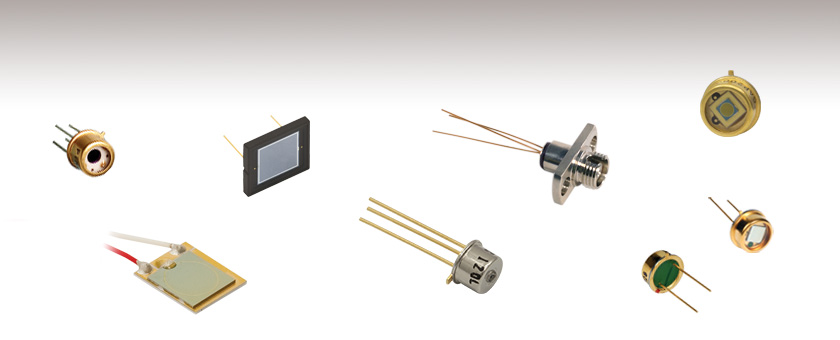
- Si, Black Si, Dual Band (Si/InGaAs), Ge, and InGaAs Detectors Available
- Available in TO Can, FC Connector, and Flat Wafer Body Styles
- Available in Hermetically Sealed Packages
DSD2
FDS10X10
FDG05
FGA01
FGA01FC
FDG03
FGA21
Front
Back

Please Wait
| Mounted and Unmounted Detectors |
|---|
| Unmounted Photodiodes (200 - 2600 nm) |
| Calibrated Photodiodes (350 - 1800 nm) |
| Mounted Photodiodes (200 - 1800 nm) |
| Thermopile Detectors (0.2 - 15 µm) |
| Photovoltaic Detectors (2.0 - 10.6 µm) |
| Pigtailed Photodiodes (320 - 1000 nm) |
特長
- Si、ブラックシリコン(Si)、デュアルバンド(Si/InGaAs)、Ge、InGaAsのフォトダイオード(マウント無し)をご用意
- 波長範囲:200~2600 nm
- SiフォトダイオードFDS100は、5、10、50個入りパックの製品もご用意
当社では、さまざまな受光面サイズやパッケージのPIN接合型フォトダイオード(PD)を標準品として取り揃えています。PIN接合型フォトダイオードのラインナップにはシリコン(Si)とインジウムガリウムヒ素(InGaAs)が含まれます。また、N-on-P構造のゲルマニウム(Ge)もございます。
これらの中で最も高速なフォトダイオードはSiフォトダイオードのFDS015、FDS02、FDS025です。SiフォトダイオードFDS015は立ち上がり時間が35 ps、接合静電容量が0.65 pFで、下記でご紹介している中で最も高速かつ最も低い静電容量のフォトダイオードです。また、SiフォトダイオードFD11Aの暗電流は2 pAで、当社のフォトダイオードの中で最も小さいものになっております。DSD2はデュアルバンドフォトダイオードで、2つのフォトディテクタが重ねられており(InGaAS基板の上にSi基板)、波長範囲は2つの組み合わせにより400~1700 nmです。FD05DとFD10Dは900~2600 nmで感度が高いInGaAsフォトダイオードで、一般的なInGaAsフォトダイオードの長波長側感度域が~1800 nmであるのに対し、より長波長側まで伸びています。
フォトダイオード製品のラインナップに加えて、マウント付きフォトダイオードと豊富な種類のフォトダイオード用ソケットもご用意しております。なお下記のフォトダイオードは校正されていませんのでご注意ください。そのため製造ロットによって感度が若干異なる場合があります。詳細は「感度の変動」のタブをご参照ください。当社では感度のばらつきを補正した、NISTトレーサブルな校正済みフォトダイオードもご用意しております。当社の多くのフォトダイオードは、DCバイアスモジュールPBM42で逆バイアス電圧をかけることができ、光パワーのより高速かつより高感度での検出が可能です。
フォトダイオードの飽和限界、ノイズフロア、受光面の均一性(または感度のばらつき)、暗電流の温度依存特性などに関して、当社が実施した実験の結果を「実験データ」タブでご覧いただくことができます。また、そちらのタブでは当社のフォトダイオードの仕様を決める際に用いる理論や方法の概要についても述べています。例えば「ノイズ等価電力(NEP)の温度依存特性」では、NEPの値がショットノイズと熱ノイズによって定義される背景が書かれています。ゼロバイアス(光起電力モード)においては、NEPはフォトダイオードのシャント抵抗によって生じる熱ノイズのみで決定されます。一方、「フォトダイオードチュートリアル」タブでは、フォトダイオードの動作、関連用語そして理論など一般的な情報がご覧いただけます。
なお、受光面のエッジ部分の不均一性により不要な静電容量や抵抗が発生し、フォトダイオードの時間領域での応答を歪ませる場合があります。このような現象を防ぐために、光はフォトダイオードの受光面の中心に入射することをお勧めしています。これはディテクタの前に集光レンズやピンホールを配置することで実現できます。
当社では、Siフォトダイオードの応答の一様性を向上させることができるスペクトル特性平坦化フィルタもご用意しております。詳細はこちらのページをご覧ください。
個別のフォトダイオードの感度特性はロットごとに異なります。 したがって、お届けしたフォトダイオードの感度特性は下記掲載の値とわずかに異なる場合がございます。 例えば右のグラフは、フォトダイオードFDS1010の感度特性が変動する範囲を示しています。 このデータは104個のフォトダイオードから収集したものです。 各データポイントにおいて感度特性の最大値、平均値、および最小値を計算し、プロットしています。
個別のフォトダイオードの、典型的な分光感度特性は、下記の製品仕様表内の![]() ボタンをクリックするとご覧いただけます。
ボタンをクリックするとご覧いただけます。
フォトダイオードのチュートリアル
動作原理
接合型フォトダイオードは、通常の信号ダイオードと似た動作をする部品ですが、接合半導体の空乏層が光を吸収すると、光電流を生成する性質があります。フォトダイオードは、高速なリニアデバイスで、高い量子効率を達成し、様々な用途で利用することが可能です。
入射光の強度に応じた、出力電流レベルと受光感度を正確に把握することが必要とされます。図1は、接合型フォトダイオードのモデル図で、基本的な部品要素が図示されており、フォトダイオードの動作原理が説明されています。

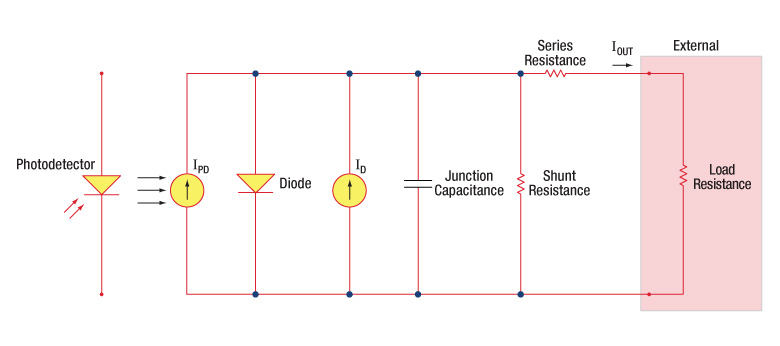
図1:フォトダイオードの概略図
フォトダイオード関連用語
受光感度
フォトダイオードの受光感度は、規定の波長における、生成光電流 (IPD)と入射光パワー(P)の比であると定義できます。

Photoconductiveモード(光導電モード)とPhotovoltaicモード(光起電力モード)
フォトダイオードは、Photoconductiveモード(逆バイアス) またはPhotovoltaicモード(ゼロバイアス)で動作できます。 モードの選択は、使用用途で求められる速度と、許容される暗電流(漏れ電流)の量で決まります。
Photoconductiveモード(光導電モード)
Photoconductiveモードでは、逆バイアスが印加されますが、これが当社のDETシリーズディテクタの基本です。回路で測定できる電流量はフォトダイオードに照射される光の量を反映します。つまり、測定される出力電流は、入射される光パワーに対しリニアに比例します。逆バイアスを印加すると、空乏層を広げて反応領域が広くなるため、接合容量が小さくなり、良好な線形応答が得られます。このような動作条件下では、暗電流が大きくなりがちですが、フォトダイオードの種類を選ぶことで、暗電流を低減することもできます。(注:当社のDETディテクタは逆バイアスで、順方向バイアスでは動作できません。)
Photovoltaicモード(光起電力モード)
Photovoltaicモードでは、フォトダイオードはゼロバイアスで使用されます。デバイスからの電流の流れが制限されると電位が上昇します。このモードでは光起電力効果が引き起こされますが、これが太陽電池の基本です。Photovoltaicモードでは、暗電流は小さくなります。
暗電流
暗電流とは、フォトダイオードにバイアス電圧が付加されている時に流れる漏れ電流です。Photoconductiveモードで使用する場合に暗電流の値は高くなりがちで、温度の影響も受けます。 暗電流は、温度が10°C上昇するごとに約2倍となり、シャント抵抗は6°C の上昇に伴い倍になります。高いバイアスを付加すれば、接合容量は小さくなりますが、暗電流の量は増大してしまいます。
暗電流の量はフォトダイオードの材料や検出部の寸法によっても左右されます。ゲルマニウム製のデバイスでは暗電流は高くなり、それと比較するとシリコン製のデバイスは一般的には低い暗電流となります。下表では、いくつかのフォトダイオードに使用される材料の暗電流の量と共に、速度、感度とコストを比較しています。
| Material | Dark Current | Speed | Spectral Range | Cost |
|---|---|---|---|---|
| Silicon (Si) | Low | High Speed | Visible to NIR | Low |
| Germanium (Ge) | High | Low Speed | NIR | Low |
| Gallium Phosphide (GaP) | Low | High Speed | UV to Visible | Moderate |
| Indium Gallium Arsenide (InGaAs) | Low | High Speed | NIR | Moderate |
| Indium Arsenide Antimonide (InAsSb) | High | Low Speed | NIR to MIR | High |
| Extended Range Indium Gallium Arsenide (InGaAs) | High | High Speed | NIR | High |
| Mercury Cadmium Telluride (MCT, HgCdTe) | High | Low Speed | NIR to MIR | High |
接合容量
接合容量(Cj)は、フォトダイオードの帯域幅と応答特性に大きな影響を与えるので、フォトダイオードの重要な特性となります。ダイオードの面積が大きいと、接合容量が大きくなり、電荷容量は大きくなります。逆バイアスの用途では、接合部の空乏層が大きくなるので、接合容量が小さくなり、応答速度が速くなります。
帯域幅と応答性
負荷抵抗とフォトディテクタの接合容量により帯域幅が制限されます。最善の周波数応答を得るには、50 Ωの終端装置を50 Ωの同軸ケーブルと併用します。接合容量(Cj)と負荷抵抗値(RLOAD)により、帯域幅(fBW)と立ち上がり時間応答(tr)の概算値が得られます。

雑音等価電力
雑音等価電力(NEP:Noise Equivalent Power)とは、出力帯域幅1 Hzでの信号対雑音比(SNR)が1になる入力信号のパワーです。NEPによって、ディテクタが低レベルの光を検知する能力を知ることができるので、この数値は便利です。一般には、NEPはディテクタの検出部の面積増加に伴って大きくなり、下記の数式で求めることができます。

この数式において、S/Nは信号対雑音比、Δf はノイズの帯域幅で、入射エネルギ単位はW/cm2となっています。詳細は、当社のホワイトペーパー「NEP – Noise Equivalent Power」をご覧ください。
終端抵抗
オシロスコープでの測定を可能にするためには、生成された光電流を電圧(VOUT)に変換する必要がありますが、負荷抵抗を用いて電圧変換します。

フォトダイオードの種類によっては、負荷抵抗が応答速度に影響を与える場合があります。最大帯域幅を得るには、50 Ωの同軸ケーブルを使用して、ケーブルの反対側の終端部で50 Ωの終端抵抗器の使用を推奨しています。このようにすることで、ケーブルの特性インピーダンスとマッチングできて共鳴が最小化できます。帯域幅が重要ではない特性の場合は、RLOADを増大させることで、所定の光レベルに対して電圧を大きくすることができます。終端部が不整合の場合、同軸ケーブルの長さが応答特性に対して大きな影響を与えます。したがってケーブルはできるだけ短くしておくことが推奨されます。
シャント抵抗
シャント抵抗は、ゼロバイアスフォトダイオード接合の抵抗を表します。理想的なフォトダイオードでは、シャント抵抗は無限大となりますが、実際の数値はフォトダイオードの材料の種類によって、10Ωのレベルから 数千MΩの範囲となる場合があります。例えばInGaAsディテクタのシャント抵抗は、10 MΩのレベルですが、GeディテクタはkΩのレベルです。このことは、フォトダイオードのノイズ電流に大きく影響を与える可能性があります。しかしながらほとんどの用途では、ある程度高い抵抗値であればその影響は小さく、無視できる程度です。
直列抵抗
直列抵抗は半導体材料の抵抗値で、この低い抵抗値は、通常は無視できる程度です。直列抵抗は、フォトダイオードの接触接続部とワイヤ接続部で発生し、ゼロバイアスの条件下でのフォトダイオードのリニアリティの主な決定要因になります。
一般的な動作回路
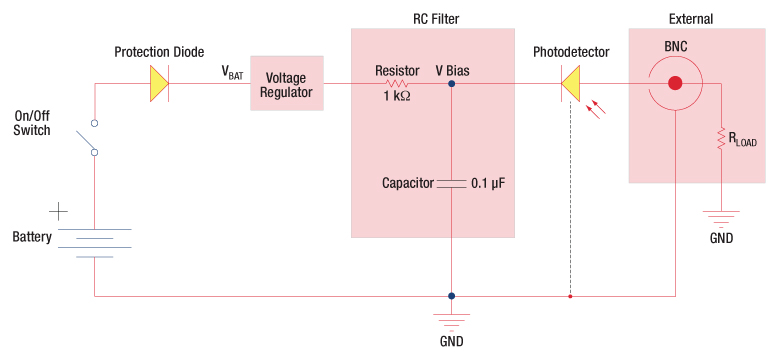
図2: 逆バイアス回路(DETシリーズディテクタ)
上図の回路はDETシリーズのディテクタをモデル化したものです。ディテクタは、入射光に対して線形の応答を得るために逆バイアス状態になっています。ここで生成された光電流の量は、入射光と波長に依存し、負荷抵抗を出力端子に接続すると、オシロスコープでモニタリングできます。RCフィルタの機能は、出力に雑音を載せてしまう可能性のある供給電力からの高周波雑音のフィルタリングです。

図3: 増幅ディテクタ回路
高利得用途でアンプとともにフォトディテクタを使用できます。動作時には、PhotovoltaicモードまたはPhotoconductiveモードのいずれも選択可能です。このアクティブ回路はいくつかの利点があります。
- Photovoltaicモード:オペアンプで、点Aと点Bの電位が同じに維持されているので、フォトダイオードでは回路全体では0 Vに保たれています。このことで暗電流は発生しなくなります。
- Photoconductiveモード: フォトダイオードは逆バイアス状態であるので、接合容量を低下させ、帯域幅の状態を改善します。ディテクタの利得は、フィードバック素子(Rf)に依存します。ディテクタの帯域幅は、下記の数式で計算することができます。
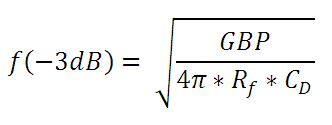
GBPが利得帯域幅積で、CDは接合容量と増幅器の静電容量の和です。
チョッパ入力周波数の影響
光導電信号は時定数の応答限界までは一定となりますが、PbS、 PbSe、HgCdTe (MCT)、InAsSbなどのディテクタにおいては、1/fゆらぎ(チョッパ入力周波数が大きいほどゆらぎは小さくなる)を持つため、低い周波数の入力の場合は影響が大きくなります。
低いチョッパ入力周波数の場合は、ディテクタの受光感度は小さくなります。周波数応答や検出性能は下記の条件の場合において最大となります。
![]()
概要
こちらのタブでは当社が提供するフォトダイオードの性能に関して実施した実験をまとめています。それぞれのセクションごとに独立した実験について記載しており、下の各ボックスをクリックするとご覧いただけます。「フォトダイオードの飽和限界とノイズフロア」では、温度、抵抗率、逆バイアス電圧、応答特性、システムの帯域幅などがフォトダイオードの出力ノイズに与える影響を調べています。「 フォトダイオードの感度均一性」では、フォトダイオードの受光面全体をビーム径の小さな光で走査し、感度の変化を調べています。素材構成の異なるフォトダイオードについての試験を行ったほかに、ユニットごとのバラツキを調べるためにシリコン(si)ベースの1種類のモデルの8ユニットについても試験をして比較しています。「暗電流の温度特性」および「ノイズ等価パワー(NEP)の温度特性」では、暗電流およびNEPがそれぞれ温度によってどのように変化するか、そしてそれが測定結果にどのような影響を与えるかを記述しています。「ビームサイズとフォトダイオードの飽和」では、フォトダイオードの飽和点が入射光のビームサイズによってどのように変化するかを示し、それらの結果を説明するために複数の理論モデルについて調べています。「バイアス電圧」では、入射光パワーがフォトダイオードの電子回路における有効逆バイアス電圧に与える影響を調べ、その変化を予測するモデルの信頼性を検証しています。
フォトダイオードの飽和限界とノイズフロア
ここでは当社のシリコンフォトダイオードの飽和限界とノイズフロアの測定結果をご紹介しています。フォトダイオードはすべて同じように機能しますが、フォトダイオードのノイズフロアと飽和限界はセンサ温度、抵抗率、逆バイアス電圧、応答特性、そしてシステムの帯域幅など多くのパラメータの影響を受けます。この実験ではシリコンフォトダイオード光検出システムにおける逆バイアス電圧と負荷抵抗の影響について調べました。逆バイアスの増加により飽和限界値は上がりましたが、ノイズフロアへの影響はわずかでした。負荷抵抗を小さくするとノイズフロアは測定システムのノイズレベルまで下がりましたが、飽和限界値も下がりました。これらの結果は逆バイアス電圧および負荷抵抗を選択する上で考慮すべき点を示しており、また、検出システムを構成する際にはすべての部品から生じるノイズを考慮すべきであることを示しています。
実験にはシリコンフォトダイオードFDS100を使用しました。光源には光パワーが0~50 mWのファイバーピグテール付き半導体レーザからのコリメート光を使用しています。コリメート光はまずビームスプリッタに入射しますが、大部分の光は透過して試験対象のフォトダイオードに入射するようにし、反射された残りの光は参照用のパワーセンサに入射しました。この状態で負荷抵抗と逆バイアス電圧を様々に変化させ、フォトダイオードの応答特性を評価しました。
右ならびに下のプロット図では、様々なテストに対する測定結果をまとめています。これらのグラフにより、様々な逆バイアス電圧ならびに負荷抵抗下でのフォトダイオードの線形応答性、ノイズフロア、そして飽和限界の変化がご覧いただけます。図1は5 Vの逆バイアス電圧ならびに10 kΩの負荷抵抗におけるフォトダイオードの応答特性です。出力電圧が逆バイアス電圧に近づくと、フォトダイオードの応答は上限値で飽和します。応答の下限値であるノイズフロアは、暗電流ならびに負荷抵抗の熱雑音(ジョンソンノイズ)によるものです。図2は、1 kΩの負荷抵抗のもとで逆バイアス電圧を様々に変えた時のフォトダイオード出力の測定結果をまとめています。逆バイアス電圧を(仕様値内で)増加させると飽和限界値が上がることを示しています。図3では5 Vの逆バイアス電圧のもとで様々に負荷抵抗値を変えたときのフォトダイオード出力電圧の測定結果です。負荷抵抗を増やすと、電圧応答の傾斜が急峻になることを示しています。図4では0 Vの逆バイアス電圧のもとで、負荷抵抗値を様々に変えたときのノイズフロアの測定結果をまとめています。負荷抵抗が大きくなるとノイズフロアも上昇します。なお、1 kΩのデータでは、測定システム内の電圧ノイズによりジョンソンノイズの理論値以上の値が測定されました。5 Vの逆バイアス電圧でのノイズフロアの変化は全体的に僅かでした。この実験に使用された装置や実験結果のまとめはこちらをクリックしてご覧ください。
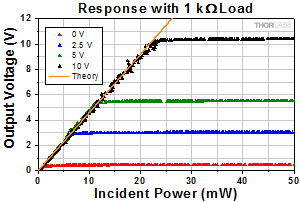
Click to Enlarge
図2. 出力電圧の逆バイアス電圧依存性
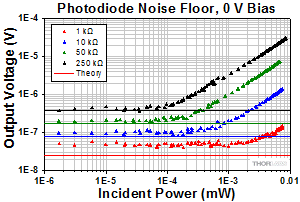
Click to Enlarge
図4. 様々な負荷抵抗における応答特性
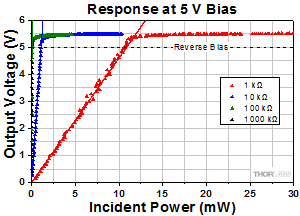
Click to Enlarge
図3. 様々な負荷抵抗におけるノイズフロア
フォトダイオードの感度均一性
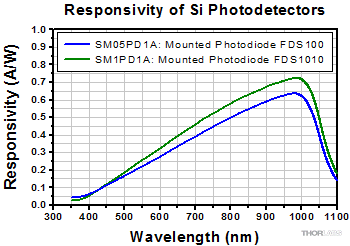 Click to Enlarge
Click to Enlarge図1:感度はフォトディテクタから出力される光電流の大きさと入射光パワーとの関係を示し、入射光の波長に依存します。
フォトダイオードの感度は受光面全体で均一か?
フォトディテクタからの出力信号の大きさは、入射光のパワーと波長に依存します。感度は出力信号と入射光パワーの関係を表し、その大きさは出力される光電流を入射光パワーで割った値になります。感度の単位はamps/wattですが、その値は波長によっても変化します。しかし、フォトダイオードの受光面内のどの部分に光が入射するかで感度が変化することは、しばしば見過ごされがちです。
この実験では、フォトダイオードの受光面よりも小さいビーム径の光で受光面全体を走査し、フォトディテクタの感度の変化を調べました。試験したフォトディテクタは、ガリウムリン(GaP)、シリコン(Si)、インジウムガリウムヒ素(InGaAs)、ゲルマニウム(Ge)のマウント済みフォトダイオードです。
感度の波長依存性1,2
感度が波長によって変化する一つの理由は、光パワー、波長、および光生成電子の関係性にあります。受光面に光ビームが入射したとき、ビーム内のエネルギを光の入射時間で割った値に等しい光パワーがディテクタに供給されます。単一波長のビームのエネルギは、入射する光子数に単一光子のエネルギを掛けた値と等しくなります。光の波長が短くなると光子のエネルギは大きくなります。もし波長が短くなっても光パワーが同じならば、入射する光子数が減少したことを意味します。
フォトディテクタ内では、単一光子からは単一の電子しか生成できません。そのため、光パワーを一定に保ったまま入射光の波長を短くすると光電流は減少します。感度は単位時間あたりの入射光子数ではなく、入射光パワーに対して出力される光電流の大きさを表すため、波長が短いと感度は低くなります。図1の感度曲線は、波長が長くなると感度が大きくなる様子を表している例です。
長波長側におけるフォトディテクタの感度は、半導体材料固有の特性によって制限されます。入射光子が光電流に寄与するには、光子は電子をホスト原子との結合から解放するのに十分なエネルギを持っている必要があります。長波長側の限界を超えた波長域では、光子のエネルギは電子を解放するのに十分ではなくなります。この限界の波長はフォトダイオードを構成する半導体材料によって決まります。
フォトダイオード受光面内の感度分布1,2
光子のエネルギを吸収してホスト原子との結合から解放された電子は、光生成電子となります。光生成電子は、電子が生成された場所から半導体材料を通過して電極との接続部まで移動した場合にのみ光電流に寄与します。光生成電子がその接続部に到達する前に半導体材料に再吸収されてしまうと、光電流には寄与しません。その可能性は半導体材料内に欠陥がある場合に大きくなります。
欠陥とは半導体の結晶格子が不完全な部分のことで、結晶格子内の転位、不純物、ボイドなどが含まれます。また、実際の結晶は大きさが有限であり、その表面も欠陥になります。完全結晶であるためには長さ、高さ、幅ともに無限である必要があります。半導体結晶内の欠陥では光生成電子は高い確率で吸収され、電子は光電流に寄与することなく、そのエネルギは熱に変えられてしまいます。
欠陥付近に発生した光生成電子は再吸収されやすく、従って光電流には寄与しにくくなります。半導体内の欠陥密度を小さくすることはできますが、フォトダイオードに使用されている半導体結晶は完全ではありません。欠陥密度が半導体結晶の体積内で一様でないことや、ある種の半導体材料の結晶成長では他の材料よりも多くの欠陥が生じやすいといったことは珍しいことではありません。
もし半導体材料の体積内での欠陥密度が一様でなければ、各領域で発生する光電流の大きさは異なると考えられます。フォトディテクタの感度は光電流の大きさに依存するため、フォトディテクタに入射する光の位置を変えたときに、欠陥密度の変化に伴って感度も変わることになります。この影響を以下の方法で調べました。
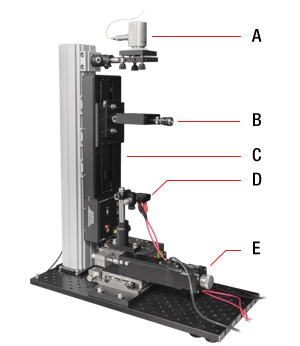
Click to Enlarge
図2: フォトダイオード受光面における感度の変化を測定するためのセットアップ。写真に見えるコンポーネントは以下の通りです:(A)反射型コリメータ、(B)アクロマティック複レンズ、(C)垂直方向に取り付けられた直線移動ステージ、(D)試験対象のフォトディテクタ、 (E)2台の水平移動ステージ
実験セットアップと実験結果
測定の目的
複数のフォトディテクタに対して、受光面における感度の均一性を調べるための試験を行いました。GaP(1台)、Si(4台)、InGaAs(2台)、Ge(2台)をベースにしたフォトディテクタの感度均一性を、波長を選択して測定しました。試験内容は以下の通りです。
- 9台のフォトディテクタを全てピーク感度に近い波長で試験 (結果はページ下の表1を展開するとご覧いただけます)
- Si、InGaAs、Geをベースにしたフォトディテクタを3種類の波長で試験 (結果はページ下の表2を展開するとご覧いただけます)
- 8台のSiをベースにしたフォトディテクタをピーク感度に近い波長で試験 (結果はページ下の表3を展開するとご覧いただけます)
実験セットアップ(文中の記号は図2に示すコンポーネントの記号に対応)
この実験セットアップでは、まず光源(写真には表示されていません)と、キネマティックマウントKM100Tに取り付けられたコリメータRC12APC-P01(A)とをファイバで結合しています。次に、マウントST1XY-D(/M)内に取り付けられた焦点距離150 mmのアクロマティック複レンズAC254-150-A(B)を用いて、光をフォトディテクタ(D)の受光面上に集光します。フォトディテクタは磁気接合式の脱着式キャリッジセットKB1P(/M)を用いて取り付けられています。 垂直アーム内の他のコンポーネントとして、電動式直線移動ステージLTS150(/M)(旧製品)(C)、垂直取付けプレートXT66P1、66 mmコンストラクションレールXT66-500、および4つのクランププラットフォームXT66C4が用いられています。水平アーム内のコンポーネントとしては、2つの電動式直線移動ステージLNR50S(/M)(旧製品)(E)、XYアダプタープレートLNR50P3(/M)、ベースプレート1つ、およびフォトディテクタ(D)の受光面上でビームを走査するための2つの閉ループステッピングモーターコントローラBSC201(写真には表示されていません)が用いられています。 ほとんどの光源は当社のスーパールミネッセントダイオードシリーズを使用しています。405 nm光源のみ例外で、ベンチトップ型レーザ光源S3FC405を使用しています。
手順
ビーム径はフォトディテクタの受光面積に合わせて調整し、各フォトダイオードの受光面を60 x 60のグリッドに分割して約3600箇所で測定しました。各フォトダイオードに入射したビーム径は50 µm~500 µmで、個々の測定で使用したビーム径についてはページ下の表を展開し、プロット図の説明をご覧ください。説明は対象のプロット図をクリックするとご覧いいただけます。
受光面を走査するとき、ビームは静止しています。これに対してフォトディテクタは、2台の電動ステージLNR50S(/M)により光軸に対して垂直な2方向に移動します。フォトディテクタの全ての受光面を試験するため、走査面の面積は受光面よりも大きくしました。
この試験では、フォトダイオードに対して逆バイアス電圧は印加していません。
結果(下記のMore [+]をクリックすると表が展開され、Less [-]をクリックすると閉じます。)
測定データは規格化され、測定位置ごとにプロットされています。各データは受光面中心での測定値で規格化し、各フォトディテクタの受光面の感度分布を示すプロット図にしています。これにより9種類のフォトディテクタの測定結果を比較できます。ノイズと区別がつかないデータポイントは削除するように処理しています。この処理は各フォトディテクタの受光面外の測定データを削除するのにも適用しています。ただし、この方法では受光面のエッジ、あるいはその近傍の測定値も削除してしまうことがあります。このような領域からの光電流が小さい原因としては、ビームスポットの一部が受光面の外側の領域にあたっていること、エッジ付近における欠陥の密度が高いために光電流が抑制されていることなどが考えられます。
プロット図は下の表を展開してご覧いただけます。各プロット図の点線は、フォトダイオード受光面の中心部の面積90%を占める部分を表しています。一般的な用途では、エッジの影響を避けるためにビームは中心部の90%の領域内に入射するようにしてください。各プロット図をクリックするとフォトダイオードの受光面積や走査に使用したビームサイズについての情報が表示されます。
この試験ではフォトダイオードのサンプルサイズ数が少ないため、これらの測定値は同型のフォトディテクタの代表値ではありますが、同じ型番でも製品ごとに測定結果は異なります。これらのフォトダイオードについて得られた測定結果は繰り返し得ることができます、半導体結晶は個体ごとに異なるため測定結果は製品ごとに異なります。以下に3つの表を掲載しています。
- 表1:受光面内の感度の変化量は、GeおよびGaPをベースにしたフォトディテクタの方が、SiおよびInGaAsをベースにしたフォトディテクタに比べて大きくなっています。このことは、SiおよびInGaAsをベースにした半導体材料の方が、GeおよびInGaAsをベースにした半導体材料よりも、欠陥密度が均一であることを示しています。
- 表2:Si、InGaAsおよびGeをベースにしたフォトディテクタの受光面内の感度の変化量は波長によって異なります。各フォトディテクタのこの感度の変化量は、ピーク感度の波長値付近で最小になります。
- 表3:Siベースの8台の同型フォトディテクタは、受光面内の感度均一性が同様であることを示しています。
| 1) 9台のフォトディテクタ:ピーク感度付近の波長に対する感度の均一性 |
|---|
| 測定したフォトディテクタ | 記載された波長における受光面の感度分布 | 分光感度特性のグラフ(典型値) | |
| GaP-Based Photodetector SM05PD7A: Mounted Photodiode FGAP71 | 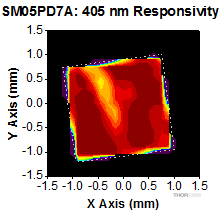 Click for Details | 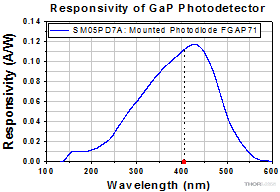 Click to Enlarge | |
| Si-Based Photodetectors SM05PD2A: Mounted Photodiode FDS010 and SM1PD2A | 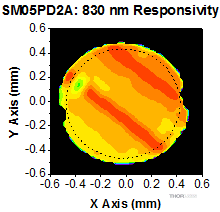 Click for Details | 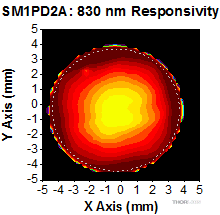 Click for Details | 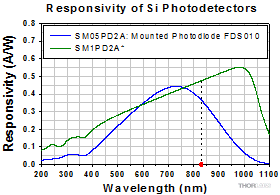 Click to Enlarge Click to Enlarge |
| Si-Based Photodetectors SM05PD1A: Mounted Photodiode FDS100 and SM1PD1A: Mounted Photodiode FDS1010 | 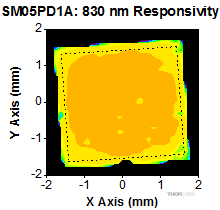 Click for Details |  Click for Details | 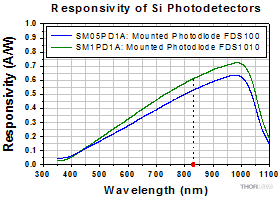 Click to Enlarge Click to Enlarge |
| InGaAs-Based Photodetectors SM05PD5A: Mounted Photodiode FGA21 and SM05PD4A: Mounted Photodiode FGA10 | 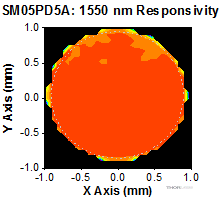 Click for Details |  Click for Details |  Click to Enlarge Click to Enlarge |
| Ge-Based Photodetectors SM05PD6A: Mounted Photodiode FDG1010 and SM1PD5A: Mounted Photodiode FDG03 | 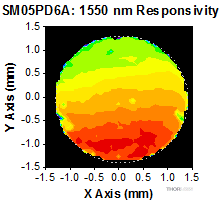 Click for Details | 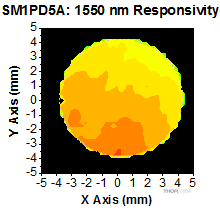 Click for Details | 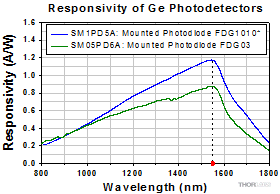 Click to Enlarge Click to Enlarge |
| 2) Si、InGaAs、Geをベースにしたフォトディテクタ:3種類の波長における感度均一性 |
|---|
| フォトディテクタ | 記載された波長における受光面の感度分布 | 分光感度特性のグラフ(典型値) | ||
| Si-Based Photodetector SM1PD1A: Mounted Photodiode FDS1010 | 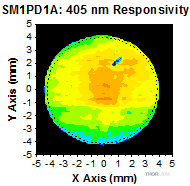 Click for Details Click for Details |  Click for Details Click for Details | 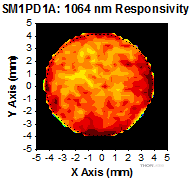 Click for Details Click for Details |  Click to Enlarge Click to Enlarge |
| InGaAs-Based Photodetector SM05PD5A: Mounted Photodiode FGA21 |  Click for Details Click for Details |  Click for Details Click for Details |  Click for Details Click for Details | 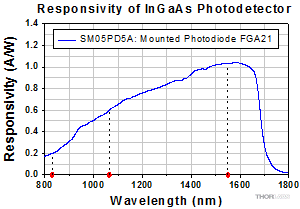 Click to Enlarge Click to Enlarge |
| Ge-Based Photodetector SM1PD5A: Mounted Photodiode FDG1010 | 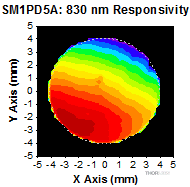 Click for Details Click for Details | 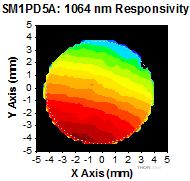 Click for Details Click for Details |  Click for Details Click for Details | 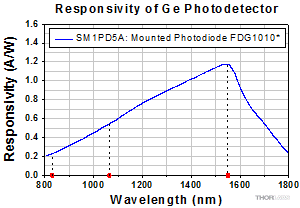 Click to Enlarge Click to Enlarge |
| 3) Siベースの8台のフォトディテクタSM1PD2A:ピーク感度付近の波長に対する感度均一性の比較 |
|---|
| 受光面の感度均一性に関する製品ごとの差異を比較するために、8台のSiベースのフォトディテクタSM1PD2Aについて測定しました。ピーク感度付近の波長である830 nmの光を用いて測定しました(右のグラフ参照)。 | 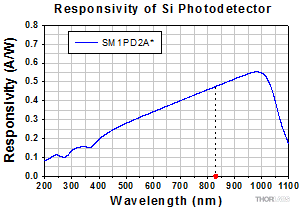 Click to Enlarge | ||
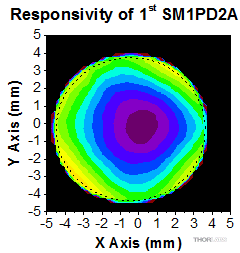 Click for Details | 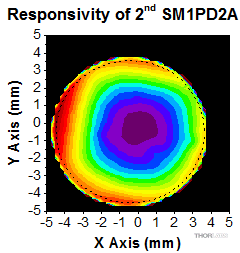 Click for Details | 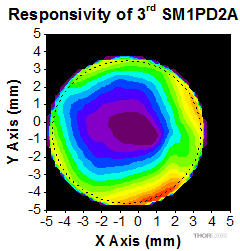 Click for Details |  Click for Details |
 Click for Details | 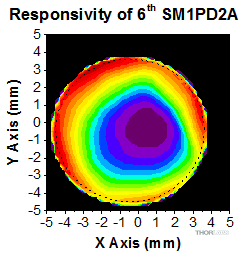 Click for Details | 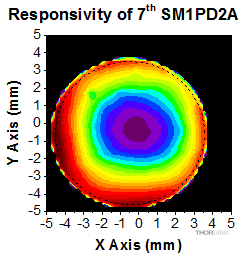 Click for Details | 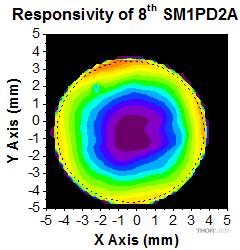 Click for Details |
参考文献
[1] G. P. Agrawal, Fiber-Optic Communication Systems, 2nd ed., John Wiley & Sons, Inc., New York, 1997. (Particularly Chapter 4)
[2] A. Rogalski, K. Adamiec, and J. Rutkowski, Narrow-Gap Semiconductor Photodiodes, SPIE Press, Bellingham, WA, 2000.
暗電流の温度特性
いくつかのマウント無しディテクタについて、暗電流の温度特性を測定しました。暗電流とは、下記に説明するように光が入射されていないときのpn接合型フォトディテクタに流れる比較的小さい電流です。ここでは、シリコン(Si)、ゲルマニウム(Ge)、ガリウムリン(GaP)、そしてインジウムガリウムヒ素(InGaAs)の逆バイアス型フォトダイオードについて、25 °C~約55 °Cの温度範囲で測定しました。
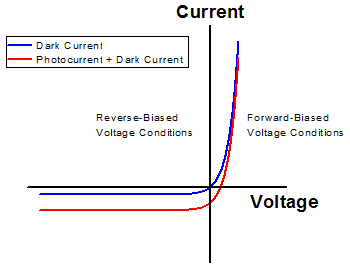
図1:pn接合型フォトダイオードの電流-電圧特性
pn接合型フォトダイオードの電流-電圧特性
pn接合型フォトダイオードの電流-電圧特性は、図1に示すように順方向バイアスと逆方向バイアスの電圧でそれぞれ特徴があります。pn接合フォトダイオードに逆バイアス電圧をかけた場合、ダイオードにかかる電位差は電流の流れる方向に対して逆方向になります。 逆バイアス型フォトダイオードに対して光が入射していないときには、電流が流れないのが理想です。
しかし実際にはフォトダイオードの半導体材料内部でのランダムプロセスにより、常に電流キャリア(電子と正孔)が生成され、それにより電流が発生します。このような電流の発生プロセスは、電子と正孔の光生成によるものではありません。それらの多くは半導体材料内部の熱エネルギによって発生します[1]。この暗電流は一般的には小さいですが、フォトダイオードに逆バイアスをかけたときには光が照射されていなくても存在します。暗電流の大きさはフォトダイオードの素材構成によって異なり、熱的な発生プロセスの効率はディテクタのセンサーヘッドに使用される半導体の種類と結晶品質に依存します。暗電流は、フォトダイオードの温度が上昇にするにつれて大きくなることが予測されます。
フォトダイオードに光が照射されると、入射光により発生した電流(光電流)が暗電流に重畳されます。光電流のキャリアは入射光子のエネルギによって生成されます。照射される光の強度がある閾値を超えると、光電流は暗電流よりも大きくなります。光電流が暗電流よりも大きい場合には、光電流の大きさは全電流を測定した後、暗電流を差し引くことによって求められます。一方、光電流が暗電流より小さい場合には、その検出は不可能です。そのため、フォトダイオードの暗電流は最小化するのが望ましいことになります。
フォトダイオードに逆電圧をかけたとき、便宜上、ここまで暗電流と光電流は電圧に依存しないものとして述べてきましたが、実際には完全に電圧に依存しないわけではありません。ダイオードに光が照射されているかどうかにかかわらず、逆バイアス電圧が上昇するにつれて電流は増加します。また、逆バイアス電圧がある閾値を超えるとフォトダイオードは降伏し、急激に大きい電流が流れてダイオードが恒久的に損傷する可能性があります。
実験:筐体付きフォトダイオードの暗電流の測定
4つの代表的なマウント無しディテクタ(SiディテクタFDS1010、GeディテクタFDG50、GaPディテクタFGAP71(旧製品)、InGaAsディテクタFGA10)について、その暗電流を25 °C~約55 °Cの温度範囲で測定しました。
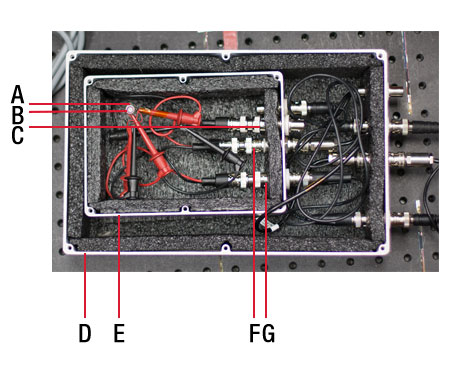
Click to Enlarge
図2:カバーを外し、FGA10を設置した入れ子式金属ボックスの試験冶具。
どちらの箱も内側は黒色の断熱材で覆われています。
A:サーミスタ、B: FGA10、C: BNC-BNCフィードスルー、D: 外側のボックス、E: 内側のボックス、F:BNC-Triaxフィードスルー、G:BNC-BNCフィードスルー
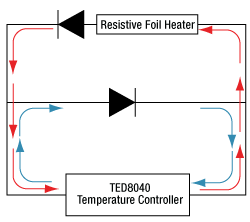
Click to Enlarge
図4: ホイルヒータ、温度コントローラTED8040、そしヒータを流れる電流を制御する2つの整流ダイオードを含む電子回路(本文参照)。
実験のセットアップ
この実験セットアップでは、フォトダイオードに一定の逆バイアス電圧を供給することや、ディテクタの温度制御、ディテクタに対する遮光などに留意し、また測定電流が電波障害(EMI)の影響を受けないように外部と絶縁してディテクタとピコアンメータKeithley 6487を接続しました。ディテクタの暗電流はnAオーダの場合もあり、正確な測定のためにはこれらの条件を制御することが重要です。
ディテクタは2つの入れ子式アルミニウム製ボックスで囲っています(図2はカバーを外した状態です)。1つのボックスのみでフォトダイオードを遮光することはできますが、実験ではEMIを遮断するために外側にもボックスを配置しています。ディテクタは内側のボックス内にあり、アンメータKeithley 6487と電気接続されています。ピコアンメータは5 Vの逆バイアスを供給し、出力電流信号を受信します。ピコアンメータとフォトダイオード間の電気信号は、複数のケーブルとフィードスルーを介して2つのボックスを通過します。5 Vのバイアス電圧は、2つの金属製ボックスの壁の中にある同軸ケーブルとBNC-BNCフィードスルーを介してフォトダイオードに接続されています。フォトダイオードからの電流信号ラインは、内側のボックスの壁の中に組み込まれているBNC-TriaxフィードスルーのBNC端子に接続されています。信号は外側のボックス内のTriaxおよびTriax-Triaxフィードスルーを通過し、ピコアンメータKeithley 6487に向かいます。同軸ケーブルは遮蔽性能が低く、それを使用してピコアンメータへ信号を送るときにはディテクタからの信号にEMI源からのノイズが混入する場合があるため、Triaxケーブルが使用されています。外側のボックスは内側のボックスをEMIから遮蔽するので、信号がディテクタからBNC-Triaxフィードスルーに移動する際に発生するノイズは低減されます。
実験中のフォトダイオードの温度は、サーミスタを用いて連続的にモニタしました。 サーミスタは熱伝導テープでFDG50、FGAP71、FGA10のTO Canに隙間なく固定されています。FDS1010のフォトセンサはセラミック製の基板に取り付けられています。実験の際、サーミスタは基板の裏側にテープで固定しました。サーミスタと温度ロガーTSP01間の電気的接続にはBNCケーブルを使用し、BNC-BNCバルクヘッドフィードスルーを通じて入れ子式ボックスの外へ信号を取り出し、カスタム仕様のBNC-フォノジャックケーブルを使用して温度ロガーに接続しました。
この試験には標準品の筐体XE25C9をベースにしたカスタム仕様の温度チャンバが使用されました。温度チャンバは図3の上段に表示されています。筐体は底面と4つの壁を有し、内側と外側の全面に絶縁体が付いています。筐体の蓋はハードボードで作られており、XE25シリーズレールで縁取られています。ハードボードの内側には絶縁体が付いています。XE25C9の筐体の壁には6個のホイルヒータが装着され、6個の熱電冷却(TEC)コントローラTED8040を取り付けたPRO8000(図3の下段に設置)によって作動します。TED8040はそれぞれヒータおよびチャンバ内に取り付けられたサーミスタに接続されています。サーミスタから読み取った値をもとにヒータ電流が決定されます。チャンバはアクティブには冷却されません。その代りにヒータを駆動する電流を止め、さらにオプションとしてチャンバの蓋を開けて冷却します。
TED8040ユニットはTECに接続可能です。電流をある方向に流すと熱が発生し、それと逆方向に流すと冷却されます。このため、筐体の温度が設定値を超えた場合、実験セットアップ内のTED8040ユニットは駆動電流を切断することはしません。その代りに電流を逆方向に流し、冷却を行います。これに対し、ホイルヒータは電流の流れる方向に関わらず熱を発生します。駆動電流をヒータから迂回させるために、2つの整流ダイオードを有する電子回路(図4参照)が設計・内蔵されています。整流ダイオードは電流を1方向にのみ流します。サーミスタに表示される温度が設定よりも低い場合、電流は赤い矢印の方向に流れてヒータを通過し、熱が発生します。筐体の温度が設定よりも高くなった場合、コントローラTED8040は電流の方向を逆向きにし、青い矢印の方向に流れるようにします。この状態では、回路内の電流はヒータの方向へは流れず、チャンバは冷却されます。
実験結果
図5は、SiディテクタFDS1010、GeディテクタFDG50、GaPディテクタFGAP71、InGaAsディテクタFGA10で測定された暗電流のグラフです。データは、25 °C~55 °Cの温度下(図6の青い領域)において連続して取得されました。図6は実験中に測定されたフォトダイオードの温度変化の代表的な例です。フォトダイオードの温度プロファイルは、温度の上昇、その後徐々に最高温度への到達、そして温度の下降というように変化します。 図5で示されているデータは、25 °C~55 °Cの間で測定された全ての暗電流です。測定のタイミングは異なりますが、電流は同じ温度において測定されています。
図5のデータ曲線は、測定された暗電流がフォトダイオードの構成材料によって異なることを示しています。暗電流値が低い順に:
- GaPディテクタFGAP71(暗電流値は最小)
- InGaAsディテクタFGA10
- SiディテクタFDS1010
- GeディテクタFDG50(暗電流値は最大)
最大値は最小値よりも6桁ほど大きくなっています。どのフォトダイオードも、温度が上昇すると暗電流も増加しています。グラフのひし形の点は25 °Cでの各ディテクタの暗電流の仕様値です。これらの点は25 °Cでの暗電流の最大値を示しています。各ダイオードは25 °Cではこの値よりも小さい値でなければなりませんが、25 °Cよりも高い温度ではこの仕様値よりも大きくなる場合があります。
実験結果についての制限事項
測定はディテクタの種類毎に1台を用いて実施しており、一般的な傾向を示すことを目的としております。よって特定のダイオードの仕様として捉えるものではありません。測定された暗電流はバイアス電圧や負荷抵抗の温度依存性、その他の様々な要因に影響されます。測定に対するそれらの影響を抑制するために、必要な5 Vの逆バイアスを供給するアンメータKeithley6487を使用するなどの工夫をしています。 アンメータを使用することにより、温度依存性があるかもしれない負荷抵抗器が不要になりました。サーミスタはできる限り半導体センサの近くに配置しましたが、直接センサには接触していません。そのため、測定温度と実際の半導体材料の温度に差があるかもしれません。暗電流は環境チャンバの温度を連続的に変化させて測定しました。この実験では湿度は制御されていません。
[1] J. Liu, Photonic Devices. Cambridge University Press, Cambridge, UK, 2005
ノイズ等価パワー(NEP)の温度特性
いくつかのマウント無しフォトディテクタについて、ノイズ等価パワー(NEP)温度特性を測定しました。下のセクションで説明しているように、NEPはフォトディテクタの最小感度を示す一般的な測定基準です。 ここでは、シリコン(Si)、ゲルマニウム(Ge)、ガリウムリン(GaP)、そしてインジウムガリウムヒ素(InGaAs)の逆バイアスされたフォトダイオードについて、25 °C~55 °Cの温度範囲で測定しました。
ノイズ等価パワー(NEP)
NEPの最も一般的な定義は、「1 Hzの出力帯域幅において信号対雑音比(SNR)が1となる入力信号のパワー」です。[1] 従って、NEPを求めるにはまず、フォトダイオードの最小ノイズを知る必要があります。光学信号をブロックしても、ディテクタ自体から発生したノイズはまだ存在します。フォトダイオードのノイズの主な原因としては、暗電流によるショットノイズとシャント抵抗による熱ノイズの2つがあります。
暗電流は、デバイスを流れる比較的小さな電流で、入射光がない状態でも存在します。暗電流についての詳細は「暗電流の温度特性」セクション内でご覧いただけます。ショットノイズは、電荷キャリアの量子化特性によって発生します。ディテクタに光が入射されていない場合は、公式を用いてディテクタの暗電流を算出することで決定できます。[2]

ここでisはショットノイズ、Idは暗電流、qは電荷、fBWは帯域幅です。帯域幅は別のフォトダイオードと比較できるように1 Hzに設定します。
熱ノイズつまりジョンソンノイズは、電荷キャリアのランダムな熱運動によるものです。熱ノイズは装置の抵抗素子によってのみ発生します。フォトダイオードディテクタの場合、シャント抵抗を考慮に入れる必要があります。シャント抵抗はゼロバイアスのフォトダイオードのpn接合における抵抗です。言い換えると、ゼロ電圧地点におけるIV特性カーブの傾きの逆数です。ゼロ点での勾配を正確に算出することは難しいため、V = ±10 mVにおける電流を測定して勾配を算出するという手法が業界で一般的に認められています。これにより、シャント抵抗による熱ノイズRSHは下記の式で表されます:

ここでitは熱ノイズ(電流として表されます)、kBはボルツマン定数、Tは温度、 RSHはシャント抵抗、fBWは帯域幅です。
ノイズの総量itotalはすべてのノイズ源の和となります:

注:この結果は、フォトダイオードの出力電流で表されるノイズの総量です。それに対して、NEPは入射した光パワーとして表されます。したがって、NEPの仕様値を比較するには、仕様の波長範囲における感度(典型値)を使用します:

また、別のダイオードと比較する際に容易に計算できるよう、帯域幅を1 Hzに設定しました。
実験:暗電流およびシャント抵抗の測定
パッケージされていない状態の代表的な4つのフォトダイオードのNEPを、25~55 °Cにおいて測定しました。測定には以下のディテクタを使用しました:SiディテクタFDS1010、GeディテクタFDG50、GaPディテクタFGAP71(旧製品)、InGaAsディテクタFGA10。

Click to Enlarge
図1: カバーを外し、FGA10を設置した入れ子式金属ボックスの試験冶具。
どちらの箱も内側は黒色の断熱材で覆われています。.
A: サーミスタ、B:FGA10、C:BNC-BNCフィードスルー、D:外側ボックス、E:内側ボックス、F:BNC-Triaxフィードスルー、G:BNC-BNCフィードスルー

Click to Enlarge
図3: 電子回路内のホイルヒータ、温度コントローラTED8040、抵抗ヒータを通過する2つの整流ダイオードの制御電流(本文参照)。
実験のセットアップ
この実験セットアップでは、フォトダイオードに一定の逆バイアス電圧を供給することや、ディテクタの温度制御、ディテクタに対する遮光などに留意し、また測定電流が電波障害(EMI)の影響を受けないように外部と絶縁してディテクタとピコアンメータKeithley 6487を接続しました。ディテクタの暗電流はnAオーダの場合もあり、正確に測定するためにはこれらの条件を制御することが重要です。
ディテクタは2つの入れ子式アルミニウム製ボックスで囲っています(図1はカバーを外した状態です)。1つのボックスのみでフォトダイオードを遮光することはできますが、実験ではEMIを遮断するために外側にもボックスを配置しています。ディテクタは内側のボックス内にあり、ピコアンメータKeithley 6487と電気接続されています。ピコアンメータは逆バイアスを供給し、出力電流信号を受信します。ピコアンメータとフォトダイオード間の電気信号は、複数のケーブルとフィードスルーを介して2つのボックスを通過します。バイアス電圧は、2つの金属製ボックスの壁の中にある同軸ケーブルとBNC-BNCフィードスルーを介してフォトダイオードに接続されています。フォトダイオードからの電流信号ラインは、内側のボックスの壁の中に組み込まれているBNC-TriaxフィードスルーのBNC端子に接続されています。信号は外側のボックス内のTriaxおよびTriax-Triaxフィードスルーを通過し、ピコアンメータKeithley 6487に向かいます。同軸ケーブルは遮蔽性能が低く、それを使用してピコアンメータへ信号を送るときにはディテクタからの信号にEMI源からのノイズが混入する場合があるため、Triaxケーブルが使用されています。外側のボックスは内側のボックスをEMIから遮蔽するので、信号がディテクタからBNC-Triaxフィードスルーに移動する際に発生するノイズは低減されます。
暗電流を測定する場合、バイアス電圧は5 Vに設定します。シャント抵抗を算出するには、バイアス電圧を+10 mVおよび-10 mVに設定して電流を測定します。
実験中のフォトダイオードの温度は、サーミスタを用いて連続モニタしました。サーミスタは熱伝導テープでFDG50、FGAP71、FGA10のTO Canに隙間なく固定されています。FDS1010のフォトセンサはセラミック製の基板に取り付けられています。実験の際、サーミスタは基板の裏側にテープで固定しました。サーミスタと温度ロガーTSP01間の電気的接続にはBNCケーブルを使用し、BNC-BNCバルクヘッドフィードスルーで入れ子式ボックスの外へ信号を取り出し、カスタム仕様のBNC-フォノジャックケーブルを使用して温度ロガーに接続しました。
この試験には標準品の筐体XE25C9をベースにしたカスタム仕様の温度チャンバが使用されました。温度チャンバは図3中の上段に表示されています。筐体は底面と4つの壁を有し、内側と外側の全ての面に絶縁体が付いています。筐体の蓋はハードボードで作られており、XE25シリーズレールで縁取られています。ハードボードの内側には絶縁体が付いています。XE25C9の筐体の壁には6個のホイルヒータが装着され、6個の熱電冷却(TEC)コントローラTED8040を取り付けたPRO8000(図2中の下段に設置)によって作動します。TED8040はそれぞれヒータおよびチャンバ内に取り付けられたサーミスタに接続されています。サーミスタから読み取った値をもとにヒータ電流が決定されます。チャンバはアクティブには冷却されません。その代りにヒータを駆動する電流を止め、さらにオプションとしてチャンバの蓋を開けて冷却します。
TED8040ユニットはTECに接続可能です。電流を一定の方向に流すと熱が発生し、逆方向に流すと冷却されます。このため、筐体の温度が設定値を超えた場合、実験セットアップ内のTED8040ユニットは駆動電流を切断することはしません。その代りに電流を逆方向に流し、冷却を行います。これに対し、ホイルヒータは電流の流れる方向に関わらず熱を発生させることができます。駆動電流をヒータから迂回させるために、2つの整流ダイオードを有する電子回路(図3参照)が設計・内蔵されています。整流ダイオードは電流を1方向にのみ流します。サーミスタに表示される温度が設定よりも低い場合、電流は赤い矢印の方向に流れてヒータを通過し、熱が発生します。筐体の温度が設定よりも高くなった場合、コントローラTED8040は電流の方向を逆向きにし、青い矢印の方向に流れるようにします。この状態では、回路内の電流はヒータの方向へは流れず、チャンバは冷却されます。
実験結果
図4は、SiディテクタFDS1010、GeディテクタFDG50、GaPディテクタFGAP71、InGaAsディテクタFGA10で測定された暗電流のグラフです。図5は、図4と同じダイオードのシャント抵抗の計算値です。データは、25 °C~55 °Cの温度下(図7の青い領域)において連続して取得されました。図7は実験中に測定されたフォトダイオードの温度変化の代表的な例です。フォトダイオードの温度プロファイルは、温度の上昇、その後徐々に最高温度への到達、そして温度の下降というように変化します。図4ならびに図5で示されているデータは、25 °C~55 °Cで測定されています。測定のタイミングは異なりますが、すべてのデバイスにおいて電流は同じ温度において測定されています。
図5で示されているように、ディテクタGaP、InGaAs、Siのシャント抵抗の測定値は比較的大きくなっているので、多くの場合、これを考慮する必要はありません。GeディテクタFDG50のシャント抵抗値は、高温においては比較的小さくなっています。このダイオードを高抵抗と共に使用する場合は、シャント抵抗を考慮に入れる必要があります。
図6では、各ダイオードのNEP計算値と温度の関係を示しています。NEPは、波長にによって変化する感度によって決まるため、ここでのNEPは右の表内に記載されているピーク感度を用いて算出されています。
| Responsivity Used for NEP Calculation | |
|---|---|
| FGA10 | 1.05 A/W @ 1550 nm |
| FDG50 | 0.85 A/W @ 1550 nm |
| FGAP71 | 0.12 A/W @ 440 nm |
| FDS1010 | 0.725 A/W @ 970 nm |
図6のデータ曲線は、測定された暗電流がフォトダイオードの構成材料によって異なることを示しています。暗電流値が低い順に:
- GaPディテクタFGAP71(NEP値は最小)
- InGaAsディテクタFGA10
- SiディテクタFDS1010
- GeディテクタFDG50(NEP値は最大)
最大値は最小値よりも6桁ほど大きくなっています。どのフォトダイオードも、温度が上昇すると暗電流も増加しています。グラフのひし形の点は25 °Cでの各ディテクタの暗電流の仕様値です。これらの点は25 °Cでの暗電流の最大値を示しています。各ダイオードの暗電流およびNEPは25 °Cではこの値よりも小さい値でなければなりませんが、25 °Cよりも高い温度ではこの仕様値よりも大きくなる場合があります。
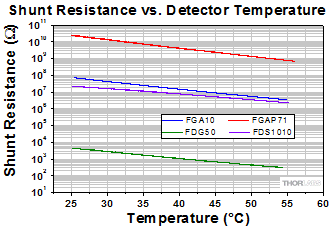
Click to Enlarge
図5: 4つのマウント無しフォトダイオードのシャント抵抗を本文中の数式を用いて算出
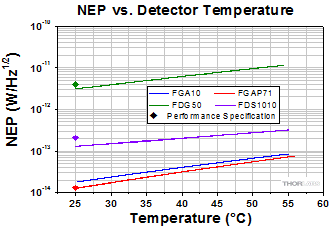
Click to Enlarge
図6: 4つのマウント無しフォトダイオードのNEPをショットノイズと熱ノイズの和で算出。
ひし形のデータ点は25 °Cでの各ディテクタのNEPの仕様値です。FGA10では、ピーク感度波長におけるNEPが規定されていないため、この仕様値のデータ点が表示されていません。
実験結果についての制限事項
測定はディテクタの種類毎に1台を用いて実施しており、全体的な傾向を示すことを目的としております。よって特定のダイオードの仕様として捉えるものではありません。測定された電流はバイアス電圧や負荷抵抗の温度依存性、その他の様々な要因に影響されます。測定に対するそれらの影響を抑制するために、必要な5 Vの逆バイアスを得るためにピコアンメータKeithley 6487を使用するなどの工夫をしています。ピコアンメータを使用することにより、温度依存性がある負荷抵抗器が不要になりました。サーミスタはできる限り半導体センサの近くに配置しましたが、直接センサには接触していません。そのため、測定温度と実際の半導体材料の温度に差があるかもしれません。電流は環境チャンバの温度を連続的に変化させて測定しました。この実験では湿度は制御されていません。
[1] 当社のホワイトペーパ「NEP – Noise Equivalent Power」より
[2] Quimby, Richard S. Photonics and Lasers: An Introduction. Wiley-Interscience, Hoboken, NJ, 2006, pp 241-244.
ビームサイズとフォトダイオードの飽和
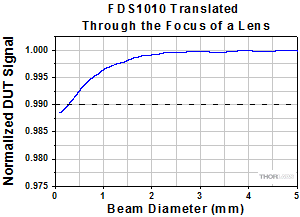
Click to Enlarge
図1: 入射パワーが一定のときの、出力電流の変化を規格化して表示。試験対象のフォトダイオード(DUT)であるFDS1010に入射するビーム径はレンズの焦点を調整して設定。
当社のシリコンフォトダイオードの飽和点とビームサイズの関係についての測定結果をご紹介します。ここでは、線形応答領域から1%の偏差が生じる状態で飽和と定義しています。図1に示されているように、ビームサイズが小さくなるとフォトダイオードが飽和する入射パワーレベルも小さくなります。飽和の変化がパワー密度によるものではないことを実証するために、計算と実験を数回追加して行っています。これらの結果は、当社のフォトダイオードパワーセンサS130Cのようなパワーセンサを用いてパワーの絶対値を測定するときは、ビームサイズを考慮に入れるべきだということを示しています。
実験ではマウント付きフォトダイオードSM1PD1Aを使用しました。この検出器はSM1シリーズネジ付き筐体にフォトダイオードFDS1010を取り付けたものです。光源には830 nmのスーパールミネッセントダイオードを使用しました。ビームスプリッタを用いて光の20%をモニタ用フォトダイオードに入射し、残りの光は集光レンズを通過させています。光パワーは積分球によって校正し、集光ビームのビームサイズは移動ステージに取り付けたビームプロファイラによって校正しました。校正後、ビームプロファイラを試験対象のデバイス(DUT)であるSM1PD1A(0 Vバイアス)と交換しました。負荷抵抗器を使わなくても済むように、出力電流はアンメータで測定しました。パワーを一定に保ちながらビーム径を0.06 mm~5 mmで連続的に変化させてデータを記録し、また1 mm~5 mm(5%のクリップレベルで測定)のビーム径に対して入射パワーを0.12 mW~5 mWで連続的に変化させて測定しました。
これらの測定結果をグラフで示しています。図1(右)は入射パワーを1 mWに固定して、ビーム径を連続的に変化させたときの線形応答からの偏差を示しています。図2(下)は異なるビーム径において入射パワーを連続的に変化させたときの線形応答からの偏差を示しています。 図1では、1 mWの入力においては、ビームサイズが300 µm未満になるとフォトダイオードは飽和することを示しています。図2では、ビーム径が2 mm以上になると実験を行ったパワーレベルでは飽和しないことを示しています。
これらの結果から、パワー密度が大きいことによる局所的な飽和は、利用可能なキャリア数が局所的に枯渇または減少することに起因するという1つの仮説を立てることができます。図3は、図2のパワーの測定値とビーム径からパワー密度を算出し、出力電流とパワー密度の関係をグラフ化したものです。もし、結果が局所的な飽和によるものだとすると、何れのビーム径においても飽和するパワー密度は同じであることが期待されます。しかし、結果はそうなっていません。
図3の結果ではビームサイズの変化と光パワー密度が連動しているので、別の実験として、ビームエリアの同一エンベロープ内においてセンサに入射するパワー密度を増加させ、それによって飽和点が変化するかどうかを調べました。具体的には、マイクロレンズアレイを用いてガウシアンビームをビームレットの配列に分割し、全ての光パワーを同じガウシアンエンベロープ内で複数の小さなスポットに集光しました。これによりパワー密度はより大きくなりますが、センサのリード線への電気的接続は同様のままです。図4は、図2の結果にマイクロレンズアレイによる結果を点線で重ねて示したものです。全てのビーム径において、元のガウシアンビームとほぼ同じ結果となっていることから、飽和は全体のビーム径に関係しており、パワー密度には依存しないことがわかります。実験データの詳細において、この実験結果はビームサイズによる飽和の変化がフォトダイオードの直列抵抗の変化によるものであるというScholze氏らの理論[1]を支持するものであることを論じています。
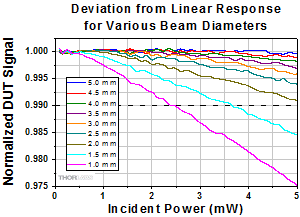
Click to Enlarge
図2: 1 mm~5 mmのビーム径において入射パワーを増大させた場合の直線応答からのパーセント偏差。1%の偏差レベルを水平の点線で示しています。
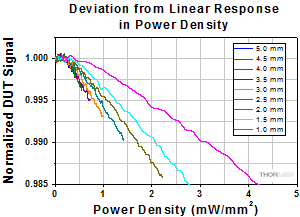
Click to Enlarge
図3: 1 mm~5 mmのビーム径における、規格化された出力電流とパワー密度との関係。このグラフは、飽和効果が同一のパワー密度で現れるわけではないことを示しています。
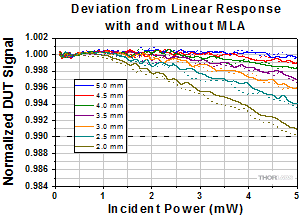
Click to Enlarge
図4: 2 mm~5 mmのビーム径における、規格化された出力電流と光パワーとの関係。フォトダイオードの前にマイクロレンズアレイ(MLA)を設置した場合(点線)と設置しなかった場合(実線)について示しています。
[1] F. Scholze, R. Klein, R. Muller, Linearity of silicon photodiodes for EUV radiation. 2004 Proc. SPIE 5374 926–34.
入射光パワーと有効逆バイアス電圧
はじめに
フォトダイオードの帯域幅(と立ち上がり時間)は、有効バイアス電圧の関数であることが知られています。つまり、要求される帯域幅を維持するためには、フォトダイオードに入射される光パワーで生成される光電流に応じて有効バイアス電圧を調整しなければなりません。この実験では、バイアス電圧を印加したフォトダイオードに関する信頼できるモデルを作るために、フォトダイオードの有効逆バイアス電圧とCWの入射光パワーとの関係を調べました。
回路の分析
まず、モデルを作るために、右の図2に示すフォトダイオードの回路に対してオームの法則を適用します。DC電圧源を一定と仮定すると、次の式が得られます。
Veff = V0 - iPD * (RP + RL)
(1)
フォトダイオードの有効バイアス電圧(Veff)は、電源電圧(V0)から、バイアスモジュールの抵抗(RP)と負荷抵抗(RL)の和に光電流 (iPD)を掛けた値を差し引いた値に等しくなります。
Veffが入射光パワー(P)によってどのように変化するかを見るために、上の式のiPDを定義に従って波長に依存するフォトダイオードの感度[ℜ(λ)] とPの積に置き換えます。
iPD = ℜ(λ) * P
(2)
負荷抵抗にオームの法則を適用してiPD = VL / RLとすることで、上の式からℜ(λ)は次のように書くことができます。
ℜ(λ) = VL / (P * RL )
(3)
負荷抵抗(VL)による電圧低下はPの増加量に比例すると仮定すると、VLとP の変化量の比は次のように表されます。
m = Δ VL / Δ P
(4)
これらの式を組み合わせると、次の式が得られます。
Veff = V0 - (m / RL) * P * (RP + RL)
(5)
mの値は各フォトダイオードのVLおよびPの測定値から計算できるため、この式はPに応じたVeffの変化を示すモデルとして使用できます。
実験
この実験ではPの変化に対するVLの変化を測定しました。ファイバに結合された半導体レーザからの出力光を、コリメートしたのちにNDフィルタを通し、さらに軸外放物面ミラーで被試験デバイス(DUT)に集光しました。実験セットアップの写真は右上の図1でご覧いただけます。様々な光学濃度のNDフィルタを使用することで、フォトダイオードへの入射光パワーを変化させました。使用したフォトダイオードごとに受光面と集光ミラー間の距離を調整し、スポットサイズがフォトダイオードの受光面積の約半分となるようにしました。V0、VL、およびVeff+VLの測定にはオシロスコープを使用しました。有効バイアスの測定にはマルチメータを直接使用しました。
結果
各DUTについてPに対するVLをグラフ化しました。Siフォトダイオードの結果例が右の図3でご覧いただけます。データセット毎に直線のトレンドラインを作成しましたが、その勾配が式(4)のmになります。この値を式(5)に用いて有効バイアス電圧を求めることができます。また、Veffの入射光パワーに対する特性をグラフ化し、オシロスコープによる測定値と比較することができます。それらの結果は、下の図4の3つのグラフに示されています。ここに示したモデルは実験による測定結果と整合性があることが分かり、それらの結果は(V0、RPおよび RLが一定の場合には)Pが増加するとともにVeffが減少することを示しています。これは重要な結果です。なぜなら電圧源に設定した電圧が必ずしもフォトダイオードに印加されるバイアス電圧にはならないからです。フォトダイオードに印加される有効バイアス電圧を求めるには、回路内の部品の抵抗を考慮しなければなりません。
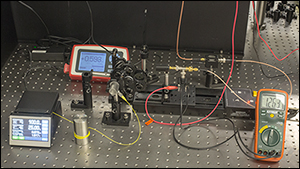 Click to Enlarge
Click to Enlarge図1: こちらの実験セットアップはフォトダイオードの有効電圧のモデルを検証するために使用されました。
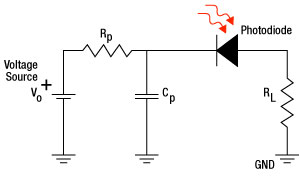
Click to Enlarge
図2: バイアス電圧が印加されたフォトダイオードの電子回路図
_Plot_G1-300.gif)
Click to Enlarge
図3: 左の式(5)のmを求めるために使用された入射光パワーと電圧の関係
About Our Lab Facts
Our application engineers live the experience of our customers by conducting experiments in Alex’s personal lab. Here, they gain a greater understanding of our products’ performance across a range of application spaces. Their results can be found throughout our website on associated product pages in Lab Facts tabs. Experiments are used to compare performance with theory and explore the benefits and drawbacks of using similar products in unique setups, in an attempt to understand the intricacies and practical limitations of our products. In all cases, the theory, procedure, and results are provided to assist with your buying decisions.
パルスレーザ:パワーとエネルギーの計算
パルスレーザからの放射光が、使用するデバイスや用途に適合するかどうかを判断する上で、レーザの製造元から提供されていないパラメータを参照しなければならない場合があります。このような場合、一般には入手可能な情報から必要なパラメータを算出することが可能です。次のような場合を含めて、必要な結果を得るには、ピークパルスパワー、平均パワー、パルスエネルギ、その他の関連するパラメータを必要とすることがあります。
- 生物試料を損傷させないように保護する
- フォトディテクタなどのセンサにダメージを与えることなくパルスレーザ光を測定する
- 物質内で蛍光や非線形効果を得るために励起を行う
パルスレーザ光のパラメータは下の図1および表に示します。参照用として、計算式の一覧を以下に示します。資料を ダウンロードしていただくと、これらの計算式のほかに、パルスレーザ光の概要、異なるパラメータ間の関係性、および計算式の適用例がご覧いただけます。
計算式 | ||||
 | 、 |  | ||
 | ||||
 | ||||
 | ||||
平均パワーから算出するピークパワー、ピークパワーから算出する平均パワー : | ||||
 | 、 |  | ||
| 平均パワーおよびデューティーサイクルから算出するピークパワー*: | ||||
 | *デューティーサイクル( ) はレーザのパルス光が放射されている時間の割合です。 ) はレーザのパルス光が放射されている時間の割合です。 | |||
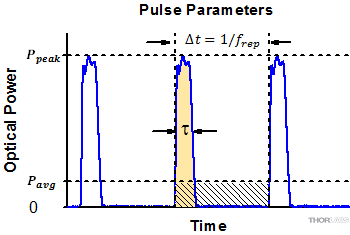
Click to Enlarge
図1: パルスレーザ光の特性を記述するためのパラメータを、上のグラフと下の表に示します。パルスエネルギ (E)は、パルス曲線の下側の黄色の領域の面積に対応します。このパルスエネルギは斜線で表された領域の面積とも一致します。
| パラメータ | シンボル | 単位 | 説明 | ||
|---|---|---|---|---|---|
| パルスエネルギ | E | ジュール[J] | レーザの1周期中に放射される1パルスの全放射エネルギ。 パルスエネルギはグラフの黄色の領域の面積に等しく、 これは斜線部分の面積とも一致します。 | ||
| 周期 | Δt | 秒 [s] | 1つのパルスの開始から次のパルスの開始までの時間 | ||
| 平均パワー | Pavg | ワット[W] | パルスとして放射されたエネルギが、1周期にわたって 均一に広がっていたと仮定したときの、 光パワーの大きさ(光パワー軸上の高さ) | ||
| 瞬時パワー | P | ワット[W] | 特定の時点における光パワー | ||
| ピークパワー | Ppeak | ワット [W] | レーザから出力される最大の瞬時パワー | ||
| パルス幅 |  | 秒 [s] | パルスの開始から終了までの時間。一般的にはパルス形状の 半値全幅(FWHM)を基準にしています。 パルス持続時間とも呼ばれます。 | ||
| 繰り返し周波数 | frep | ヘルツ [Hz] | パルス光が放射される頻度を周波数で表示した量。 周期とは逆数の関係です。 | ||
計算例
下記のパルスレーザ光を測定するのに、最大入力ピークパワーが75 mW
のディテクタを使用するのは安全かどうかを計算してみます。
- 平均パワー: 1 mW
- 繰り返し周波数: 85 MHz
- パルス幅: 10 fs
1パルスあたりのエネルギは、

と低いようですが、ピークパワーは、

となります。このピークパワーはディテクタの
最大入力ピークパワーよりも5桁ほど大きく、
従って、上記のパルスレーザ光を測定するのに
このディテクタを使用するのは安全ではありません。
| Posted Comments: | |
Wim Weltjens
(posted 2024-11-01 14:50:04.29) Hello,
I saw your new photodiode. This is a very interesting one for us, except that it is in the wrong package.
What we usually do is glue a lens onto the epoxy of a ceramic package to increase the light input without having to deal with the downsides of a larger photodiode.
Is it possible to get this photodiode in another package?
Thanks! ksosnowski
(posted 2024-11-04 04:58:19.0) Hello Wim, thanks for reaching out to us. We offer WR1 as a diode can opener to de-lid TO-can packages like FDBS22. Epoxy could interfere with the performance of the nanostructured surface of the black silicon sensor by presenting a different refractive index medium and potentially increasing the surface reflection. I have reached out directly to discuss this application in further detail. Sultan Alshaibani
(posted 2024-05-23 00:24:58.487) Dear Sir/Madam,
I hope this message finds you well.
My name is Sultan Alshaibani, and I am a PhD candidate at King Abdullah University of Science and Technology (KAUST). I am currently in the process of completing my doctoral dissertation, which focuses on the development of a silicon-based photodetector.
I am writing to request permission to extract data from Thorlabs' FDS010 Si-based photodetector.
Specifically, I would like to include the following figure in my thesis:
----------------------------------------------------------
Figure 1: Typical responsivity spectrum of Si-based photodetector.
This figures is critical to illustrating key points in my research and providing a comprehensive understanding of the subject matter.
I assure you that proper attribution will be given to the original source, and the figure will be used solely for academic purposes within my dissertation. The dissertation will be submitted to KAUST's library and may be made available online for academic and research purposes.
Please let me know if there are any forms or additional information required to process this request. I would be grateful for your consideration and approval.
Thank you very much for your time and assistance.
Best regards,
Sultan Alshaibani
PhD Candidate, Department of Computer, Electrical and Mathematical Sciences and Engineering (CEMSE)
King Abdullah University of Science and Technology (KAUST)
sultan.alshaibani@kaust.edu.sa
+966 50 057 2298 cdolbashian
(posted 2024-05-28 11:32:03.0) Thank you for reaching out to us with this inquiry and for reaching out to us to request permission to use our images in your publication. I have contacted you directly with the appropriate paperwork which will permit your use of our images. Pokuan Shen
(posted 2024-05-22 18:56:00.003) Dear Sir/Madam
This is Pokuan Shen from AuthenX, Taiwan.
I have one question regarding the FDS02. Can it support a FC/PC connector with a high NA multimode fiber Thorlabs M123L01? If so, how is the optical couplinge efficiency between the fiber and photodiode, or the responsivity of whole receiver, including photodiode and high NA fiber.
Thank you.
PK Shen cdolbashian
(posted 2024-05-24 10:48:04.0) Thank you for reaching out to us with this inquiry. These fiber-coupled diodes are designed to be used with SM fibers, as the active area is fairly small. Overfilling the area can result in slower response time and loss of signal. This may be fine depending on your application, and I have contacted you directly to discuss this. Asger Gardner
(posted 2024-02-29 09:24:34.893) Hello,
Looking through your product range of photodiodes, I cannot seem to find any that are Silicon Carbide (SiC) based. I'm looking for these with regards to solar-blind detection of UV signals, since SiC-based detectors are sensitive in the range from 200-400 nm. Of particular interest would be avalanche photodiodes for fast response to low signals. ksosnowski
(posted 2024-03-07 04:36:31.0) Hello Asger, thanks for reaching out to Thorlabs. We do not currently offer any Silicon Carbide photodiodes. We previously offered some detectors with Gallium Phosphide (GaP) photodiodes however this type of diode is no longer produced and we have so far been unable to source an exact replacement for UV detection like this. Our APD130A2 avalanche detector uses UV-enhanced Silicon to provide sensitivity down to 200nm. However this would require some optical filtering to cutoff wavelengths above 400nm. I have reached out directly to discuss your application in further detail. Hartmut Becker
(posted 2024-02-13 09:19:37.587) The junction capacitance of FDS 100 is 24 pF.
What is the value of the Sunt resistance? cdolbashian
(posted 2024-02-16 04:24:15.0) Thank you for the inquiry. The shunt resistance of the FDS100 is 1GOhm at room temp. anais leproux
(posted 2024-02-12 08:50:41.523) Hello, I would like to pair 2 photodiodes that were bought together a few years ago, model FD11A. I guess they were made from the same batch.
Could you tell me about "production linearity"? I want to make sure the specs are close enough so that I can use the 2 photodiodes in a pairing configuration.
Could you also tell me about any potential drift in performance (given these photodiodes were purchased about 4 years ago)?
Many thanks! cdolbashian
(posted 2024-02-13 01:40:07.0) Thank you for reaching out to us with this inquiry. As these products are not individually characterized for lifetime or linearity, it would behoove the end user to characterize each component individually, if they are to be used in a paired-diode application. I have contacted you directly to discuss this further. khady lo
(posted 2024-01-15 09:16:34.367) on arrive pas à voir la tension max que peut accepter la photodiode FD05D. ksosnowski
(posted 2024-01-16 10:59:19.0) Hello Khady, thanks for reaching out to Thorlabs. FD05D has a max reverse bias voltage spec of 1.8V. An engineer from your local technical support team is reaching out directly for further discussions. user
(posted 2023-12-12 23:48:05.577) What is FDS010 window thickness (fused silica) ? ksosnowski
(posted 2023-12-12 11:04:22.0) Hello, thanks for reaching out to Thorlabs. The FDS010 photodiode window is 0.5mm thick quartz glass. Takemasa Tamanuki
(posted 2023-11-27 21:00:27.57) Regarding your product of FGA01FC (InGaAs Photodiode, 300 ps Rise Time, 800-1700 nm, Ø0.12 mm Active Area, FC/PC Bulkhead),
Can this product connect FC/APC?
(I mean, does this product accept FC/APC-fiber-code as well as FC/SPC?)
Thanks. cdolbashian
(posted 2023-12-11 09:37:46.0) Thank you for reaching out to us with this inquiry. You can certainly connect an APC-terminated fiber, but due to the difference in the geometry of the terminated fiber, you will likely have some misalignment of the fiber core with respect to the active area of the sensor. In this with this in mind, I can say that it is indeed compatible, but you will likely see attenuated signal when compared to a -PC style connectorized fiber. Patryk Troc
(posted 2023-10-25 08:23:47.523) Dear Sir/Madam,
I would like to ask one question about dimensions, which diameter pins of this component have? There isn't any information about it in datasheet, In DXF file there are holes with 0.45mm diameter, this this correct dimension?
Yours faithfully,
Patryk Troc ksosnowski
(posted 2023-10-25 11:44:48.0) Hello Patryk, thanks for reaching out to Thorlabs. The pin diameter for FDS02 is 0.5mm. This model uses the same photodiode from FDS025 and it is additionally factory aligned and focused in a fiber bulkhead. However you can use the pin dimensions from this photodiode as well for reference. Ray Lambert
(posted 2023-10-04 17:53:32.297) what is the subsitute for this detector jdelia
(posted 2023-10-05 01:20:59.0) Thank you for contacting Thorlabs. While we unfortunately do not offer a direct replacement for the obsolete FGAP71, I have reached out to you directly to discuss your application and which alternative solutions may be suitable for you. Romain Fourcade
(posted 2023-09-25 15:22:35.187) Dear,
Do you think it is possible to have the FDG1010 in the same case than FDS10x10 ? It would simplify greatly the integration into our systems with 2 pins rather than 2 cables. If no, do you have a suggestion for us. Thank you in advance, best regards ksosnowski
(posted 2023-09-27 05:06:35.0) Thanks for reaching out to Thorlabs. As these photodiodes are from different OEMs, we unfortunately are unable to offer this combination of package type of the FDG10X10 photodiode. We apologize for the inconvenience and I have reached out directly to discuss your application further detail. Alastair Curnock
(posted 2023-09-18 15:43:59.613) Do you have any Tolerance/uncertainty data on the responsivity of the FD10D Photodiode. ie from the typical curve, ±X% for any given Photodiode.
I notice you provide some response variation data for the FDS1010 photodiode. Do you have anything similar for an InGaAs photodiode (preferably the FD10D)
Many Thanks ksosnowski
(posted 2023-09-27 05:59:29.0) Thanks for reaching out to Thorlabs. While we do not have an exact tolerance for the responsivity, typical variations between lots can be up to +/-10%. Devices from a single batch may have less variance though we do not typically track these photodiodes in such a serial manner. We do offer a few of our photodiodes with serial calibrations like FDS1010-CAL however the only calibrated InGaAs diode we offer is the FGA21-CAL. The calibrated photodiodes ship with an individual spectral calibration report. I have reached out directly to discuss your application in further detail. Georgi Ynkov
(posted 2022-09-15 11:32:35.93) Hello,
Can you give me the spectral responsivity of the (DSD2 - Dual Band Si/InGaAs Detector).
Best Regards
George isaac lawrence
(posted 2022-08-23 05:45:17.503) I found that the FDS010 is ESD Sensitive Device.
I want to know the amount of its sensitivity to ESD.
is there any way to measure its sensitivity to ESD? ksosnowski
(posted 2022-08-26 03:09:16.0) Hello Isaac, thanks for reaching out to Thorlabs. The FDS010 has a max reverse bias voltage limit of 25V, and we do not have an exact forward voltage limit but would expect in to be in the neighborhood of 1V or possibly less. These photodiodes damage easily when forward biased, and typically ESD events are on the ns timescale and kV range of electric potential so will easily damage in either polarity. We recommend wearing ESD protection whenever handling these units due to this. Tony Mu
(posted 2022-08-11 23:34:00.08) hi,
Can you suggest what is the rated maximum peak power of this detector (FDS-100)? ksosnowski
(posted 2022-08-17 10:22:36.0) Thanks for reaching out to Thorlabs. For the FDS100, we expect optical saturation to occur before surface damage. The leads on the detector tend to be a limiting factor in the amount of generated photocurrent the device can handle. We recommend to keep below 5mA photocurrent to avoid thermal effects leading to wire bond failure. The input light level at which this occurs will depend on the diode's responsivity at your wavelength. I have contacted you directly to discuss your application further. Pierantonio Brea
(posted 2022-02-25 06:29:32.96) is it possible to obtain info about Cj capacitance vs Bias voltage of this Photodiode
Thnaks in advance
Pierantonio ksosnowski
(posted 2022-02-25 06:57:13.0) Thanks for reaching out to us, you can view the FSD100 Capacitance vs Bias Voltage by clicking on the blue "i" icons below each diode's picture. We have the Capacitance, Dark current, and Responsivity plots, as well as download links to the excel table for each plot. Aditya Choudhary
(posted 2021-12-27 01:43:42.65) Hii can you please tell me the max incident power for FDS100? cdolbashian
(posted 2021-12-29 01:28:06.0) Thank you for reaching out to us regarding this inquiry. The max current output, to avoid damaging the diode, would be ~5mA. By using this as a max current, we can use the relationship of Responsivity = Amps/Watt to identify the max power which would be associated with the max current of 5mA. The responsivity can be found on the specsheet of the diode itself. Imke Timmermans
(posted 2021-07-13 02:10:06.797) In your information I miss the field of view. It would be nice to know this for the photodiodes. cdolbashian
(posted 2021-07-20 01:26:46.0) Thank you for reaching out to us at Thorlabs! These diodes have different packages, different transparent windows, diode-package spacings, and geometries, so the FoV will vary from part to part. I have reached out to you directly to discuss the specific diode in which you were inquiring. Denis Tihon
(posted 2021-05-21 11:04:47.487) Is the FGA01FC photodetector working when connected to an FC/APC connector? I would like to connect it directly to a TW1064R5A1A coupler. cdolbashian
(posted 2021-06-04 11:45:59.0) Thank you for reaching out to us with your inquiry! The FGA01FC has been confirmed to have similar performance with an FC/APC patch cable. The observed difference, when compared to an FC/PC connector, was less than 1 dB. Michael Linde Jakobsen
(posted 2021-05-20 03:59:42.613) Very sorry to hear that you are terminating this product. YLohia
(posted 2021-05-20 10:22:43.0) Hello, thank you for your feedback. We will consider offering an alternative to this photodiode in the future. Bo Tian
(posted 2021-04-23 11:41:33.917) What is the substitute of FGAP71? Please quote me 50 pcs. YLohia
(posted 2021-04-23 02:05:00.0) Thank you for contacting Thorlabs. There are 3 alternatives-- SM05PD7A, PDA25K2, and DET25K2. These all contain the same FGAP71 photodiode. Malcolm Higman
(posted 2021-01-18 10:11:54.67) Your data-sheet has no dimensions on the pin positions which appear to be non-standard. Do you have a drawing with the pin positions with dimensions? Thanks. Malcolm asundararaj
(posted 2021-01-26 03:28:06.0) Thank you for contacting Thorlabs. While the FDGA05 does not have a standard pin configuration, the Solidworks file can be used to find the pin spacing. I have contacted you directly about this. Ben Garber
(posted 2020-05-27 17:20:24.69) I was wondering what the window thickness is on the FDS015 (for lens matching--I'm considering the N414TM-B or C392TME-B). YLohia
(posted 2020-05-28 04:29:17.0) Thank you for contacting Thorlabs. The window thickness for this photodiode is ~0.21 mm. user
(posted 2020-04-23 11:46:32.8) You should offer the extended range InGaAs detectors in a premounted configuration. asundararaj
(posted 2020-04-23 02:06:42.0) Thank you for your valuable feedback. I have posted in our internal engineering forum about extending the line of photodiodes we offer as mounted photodiodes for future consideration. Haixuan Lin
(posted 2020-02-14 10:35:12.473) Please help to check the angle dependence of FDS1010.
If the diode emitting a cone up to 20deg in the fast axis, will it affect the responsivity of FDS1010? asundararaj
(posted 2020-02-17 10:01:36.0) Than you for contacting Thorlabs. When using a photodiode to detect a diverging beam, the detection would depend on the amount of light hitting the photodiode as well as the spatial uniformity of the diode. You can find the Spatial Uniformity of this and other diodes in the Lab Fact linked below. In addition, the FDS1010 has a broadband AR Coating on the active area. From this coating, there are some losses at higher angles of incidence due to Fresnel reflections. I will contact you via email about the angular dependence of the measured signal. Lab Fact - https://www.thorlabs.com/newgrouppage9.cfm?objectgroup_id=10741&tabname=Spatial%20Uniformity Ben Garber
(posted 2019-11-19 15:06:07.05) Dear Thorlabs,
Looking at the specs for the FDS02, it's unclear whether the responsivity is with respect to the power in the fiber or incident power. Is the responsivity defined with respect to the power in the fiber? If not, what is the coupling efficiency? asundararaj
(posted 2019-11-21 08:58:37.0) Thank you for contacting Thorlabs. The responsivity is given in terms of the power incident on the photodetector. We typically expect a coupling loss of 10% and can vary marginally based on alignment. anais leproux
(posted 2019-11-14 11:17:19.773) Hello,
I could not find the value of the shunt resistance of the photodiodes FDS100 and FD11A. Would it be possible to have them please?
Thank you,
Anais Leproux YLohia
(posted 2019-11-20 04:26:06.0) Hello Anais, thank you for contacting Thorlabs. The shunt resistances are 1 G Ohm (FDS100) and 5-100 G Ohm (FD11A) at room temperature. Please note that this parameter is not screened for individual units and can vary significantly. Scott Hunter
(posted 2019-11-12 13:07:10.057) Hello, I am considering this product in my design. Can you please let me know where I can get more detailed information on this product such as performance specifications with 0V bias? Thank you! YLohia
(posted 2019-11-12 02:34:33.0) Hello, thank you for contacting Thorlabs. The Dark Current and Capacitance values are given at various bias levels, and can be accessed by clicking on the blue "info" icon in the specs table. dayana A
(posted 2019-10-24 19:25:00.727) Please share the Maximum Forward Current of FGA01FC YLohia
(posted 2019-10-24 10:44:04.0) The maximum forward current of the FGA01FC is 5 mA. Tariq Shamim Khwaja
(posted 2019-10-08 13:55:26.557) What is the maximum input power density (damage threshold) for Ge-photodiodes? FDG10X10 asundararaj
(posted 2019-10-09 10:43:06.0) Thank you for contacting Thorlabs. We do not have estimate on the damage threshold for the photodiodes. We typically recommend keeping the output current to be <10mA to avoid the internal wire in the FDG10x10 from failing. You can estimate the output current for your input power and wavelength from the responsivity graph on the 2nd page of the spec sheet at https://www.thorlabs.com/_sd.cfm?fileName=TTN126580-S01.pdf&partNumber=FDG10X10 user
(posted 2019-08-02 09:08:10.89) What is the series resistance of the photodidoe FDS015 and FDS025? The reason behind this is the impedance matching between the output impedance of the photodiode and the input impedance of a transimpedance amplifier. YLohia
(posted 2019-08-16 02:34:12.0) Hello, thank you for contacting Thorlabs. The series resistance for both of these is on the order of 50 - 100 Ohm typically. Andrey Kuznetsov
(posted 2019-07-13 17:22:48.15) Some of these photodiodes look like a Hamamatsu product, Hamamatsu distinguishes some products as Si Photodiode and others as Si PIN Photodiode. Hamamatsu's offerings for InGaAs is exclusively for InGaAs PIN Photodiodes. Thorlabs does not distinguish photodiodes as whether they are PN or PIN. Can you explain what the effect on the specifications will be if a PIN photodiode is used in a zero bias photovoltaic mode? None of Thorlab's InGaAs are listed as PIN, and I was unable to find any vendor that sells a non-PINed InGaAs photodiode, so Thorlabs must be selling PINed photodiodes. Shouldn't PINed photodiodes be biased for they to work as specified, or will they still work fine like a regular photodiode, just slower rise/fall time and lower dark current than listed? What about saturation limit? asundararaj
(posted 2019-07-19 04:57:52.0) Without a bias voltage, the photodiode will have a much larger capacitance which leads to slower rise/fall time. Dark current spec however will not be listed under a Photovoltaic mode, because by definition of dark current, it requires a bias voltage (hence, this is sometimes specified under a very small voltage, e.g.10mV). The NEP in the photovoltaic mode would normally only accounts the noise from the shunt resistance. So it will be different as well. Our NEP spec accounts both of the Johnson noise from the shunt resistance and the shot noise from the dark current. As for the saturation power, it would decrease at 0 V Bias. (https://www.thorlabs.com/newgrouppage9.cfm?objectgroup_id=10741)
Other parameters that we do not specify can also change with and without a Bias Voltage. For instance, adding a Bias Voltage would theoritically improve linearity. Another parameter that would change is the responsivity at various wavelengths. The amount of variance would vary from diode to diode.
The InGaAs detectors that we carry are all PIN diodes. Some of our Si diodes are also PIN diodes. At higher wavelengths, the penetration depth is much larger so adding the intrinsic layer to the diode improves the diodes performance. However, in that case these photocurrents would be from diffusion and hence, its speed is much slower. user
(posted 2019-05-21 09:07:54.173) Hi,
I would like to use FDS100 Photo diode for Data communication application.
I would like to know the Pixel Size and format of FDS 100.
Please share the same at the earliest possible.
Regards YLohia
(posted 2019-05-21 08:44:32.0) Hello, the FDS100 is a silicon photodiode (not a CCD/CMOS camera), and thus, does not have a pixel size or format. That being said, it has an active area of 3.6 mm x 3.6 mm. If you are interested in cameras, please see our selection here : https://www.thorlabs.com/navigation.cfm?guide_id=2025. user
(posted 2018-10-28 13:49:13.483) Sorry,the last question I asked was sensitivity map, not responsivity plots, I still cannot find out what is the sensitivity range(in dBm). YLohia
(posted 2018-12-27 03:59:01.0) Hello, thank you for the clarification. This information can be found in our "Lab Facts" tab above, under "Photodiode Spatial Uniformity". user
(posted 2018-10-25 22:01:07.26) Hello! I want to know what is the sensitivity map of this photodiode?or what factor can take place of sensitivity? YLohia
(posted 2018-10-26 08:57:44.0) The responsivity plots can be found on the spec sheet or by clicking the blue "info" icon on the table. dylan
(posted 2018-09-05 14:10:05.543) Hi, is the pinout diagram for FGA01 viewed from the bottom? The pinout for FGA01FC explicitly states the view is from the bottom, and I believe the photodiodes are identical, but I need confirmation that this is the case.
Kindest regards, nbayconich
(posted 2018-09-06 03:12:42.0) Thank you for contacting Thorlabs. Yes that is correct, both of these photodiodes have identical pin configurations. Our pin configurations will typically show a bottom view of the photodiode housing. donyakhaledyan
(posted 2018-07-16 03:49:37.237) hello I have a question and the answer of my question
is so necessary so thank you so much if you help me.
for these detectorsfds10x10&fds1010)What is the proper interface? YLohia
(posted 2018-07-23 04:44:41.0) Hello, thank you for contacting Thorlabs. I'm not sure I understand what you mean by "what is the proper interface?". Are you asking if these detectors are fiber coupled? If you're asking about the packaging type (e.g., TO-5, etc.), unfortunately, the FDS10X10 and FDS1010 don't have a standard. I have reached out to you directly to discuss this further. lebouquj
(posted 2018-04-19 16:33:12.957) Hi, Do you sell the fiber bulkhead of FGA01FC alone (without the diode). I cannot find it in your website. Thanks, Jean-Baptiste YLohia
(posted 2018-04-20 10:56:39.0) Hello Jean-Baptiste, thank you for contacting Thorlabs. I will reach out to you directly to discuss the possibility of offering this. user
(posted 2017-07-17 15:09:46.207) I am seeing ~10x increase in responsivity for FDS010 with a reverse biased circuit like you have in your tutorial in Fig. 2. I am using 12VDC, with 1k resistor in filter, and 10k load resistor. Is this expected, or am I doing something wrong. tfrisch
(posted 2017-08-09 05:35:48.0) Hello, thank you for contacting Thorlabs. While I would not expect the responsivity to change with bias voltage, increasing the bias will increase the range over which the diode will have linear response between input power and output current before saturating. If you would like to discuss this application further, please reach out to us at TechSupport@Thorlabs.com. marty.lawson
(posted 2017-02-01 12:49:31.84) How large of a fiber optic core can the the FDS02 photo-diode be used with before coupling efficiency drops? tfrisch
(posted 2017-02-16 02:14:08.0) Hello, thank you for contacting Thorlabs. While the active area is 250um in diameter, the largest fiber we have that is smaller than that would be a 200um core. The FDS02 does not include a ball lens between the fiber and the detector. I will reach out to you with more details. faryads
(posted 2016-03-22 21:36:37.053) Hi, is the FGA01FC a multi-quantum-well structure photodiode? besembeson
(posted 2016-03-25 12:26:10.0) Response from Bweh at Thorlabs USA: The FGA01FC is not a multi-quantum-well structure. This is simply a doped InGaAs material to create a P-N junction for charge transfer when illuminated by light of suitable wavelength. Quantum wells on the other hand are heterostructure made by joining materials, in layers at the atomic level, which typically leads to an emission. akpabioubongabasi
(posted 2016-02-29 14:16:38.723) Please I need a Photodector with wide sensing area, a wavelength of 650nm and which comes with an SMA Connector besembeson
(posted 2016-03-09 12:16:53.0) Response from Bweh at Thorlabs USA: The SM05PD1A (Large Area Mounted Silicon Photodiode, 350-1100 nm, Cathode Grounded) could be a suitable recommendation. Others can be found at the following link on our website: https://www.thorlabs.com/newgrouppage9.cfm?objectgroup_id=1285 user
(posted 2015-10-16 14:16:32.147) What is the series and shunt resistance of FDS100? besembeson
(posted 2015-10-27 04:54:33.0) Response from Bweh at Thorlabs USA: We don't have the exact values from the manufacturer of the photodiode but the shunt resistance should be in the Giga Ohm range while the series resistance should be extremely low that it can be negligible. ehrler
(posted 2015-09-24 03:41:03.583) Do you offer calibration for the DSD2 photodiode?
Thanks! besembeson
(posted 2015-10-08 12:06:35.0) Response from Bweh at Thorlabs USA: This is not possible for the DSD2. There is a limitation to the minimum detector size for us to do such calibration, which is 2mm minimum. The InGaAs sensor is only about 1.5mm. jarkko.piirto
(posted 2015-03-24 10:27:03.187) I would need a photodiode set up with specific mount (3pcs) for picosecond laser alignment. Focused spot size (1/e2) is <100µm. Succesfull guidance will mean purchase.. jlow
(posted 2015-03-24 04:42:43.0) Response from Jeremy at Thorlabs: We will need more information on your application first. We will contact you directly about this. aklossek
(posted 2014-05-09 07:48:19.477) Dear ladies and gentlemen,
I am looking for a Si photodiode for a stimulated raman microscope, where the modulation of a ps-laser beam must be detected. The diode has to work in MHz range, quite large active area and must be sensitive between 800 and 1000nm. Up to now I thought about the DET100A.
But now I have doubts that it will saturate to fast. Can you suggest another diode, which saturates at high powers to detect the laser beam.
Best regards
André Klossek jlow
(posted 2014-05-13 08:43:47.0) Response from Jeremy at Thorlabs: I will contact you directly to get more information on your application and make a recommendation. tanzwei
(posted 2013-05-05 06:39:49.27) Could you like to tell me the damage threshold of FGA10 ? jlow
(posted 2013-05-09 11:19:00.0) Response from Jeremy at Thorlabs: I would recommend keeping the output current to be <10mA to avoid the internal wire in the FGA10 from failing. You can estimate the output current for your input power and wavelength from the responsivity graph on the 2nd page of the spec sheet at http://www.thorlabs.com/Thorcat/2200/FGA10-SpecSheet.pdf. jlow
(posted 2012-10-24 16:14:00.0) Response from Jeremy at Thorlabs: There's a ball lens covering the chip and it is not AR coated. t.schmoll
(posted 2012-10-18 13:30:14.92) Is there a window or a ball lens covering the chip? Is the window or ball lens AR coated? If so, for which wavelength is it optimized?
Thank you!
Tilman jlow
(posted 2012-09-05 09:15:00.0) Response from Jeremy at Thorlabs: I will get in contact with you directly to discuss about your application. kkkdane
(posted 2012-09-03 10:17:41.0) Hi, I’m a researcher in South of Korea
Recently, I am developed infrared moisture detector. And I used LED and PD that is your product.
I have a question.
What is the question PD, LD(laser diode) and LED that use infrared moisture detector or infrared moisture analyzer?
Recently, What other companies use the LED, PD that used the water detector of Commercial products?
And what is commercial product?
And, If you will give a detailed information about the LED, PD.
I appreciate your help. jlow
(posted 2012-08-23 16:31:00.0) Response from Jeremy at Thorlabs: The junction capacitance between 4V and 5V is pretty much flat. Unfortunately we do not have any data on the capacitance and fall time specs beyond 5V. Mathias.Helsen
(posted 2012-08-22 06:14:07.0) I would like to use this diode as a detector for microwave modulated light, but the fall time at 5V is too high. How much doe the capacitance and fall time change when the bias voltage is increased? jlow
(posted 2012-08-17 11:16:00.0) Response from Jeremy at Thorlabs: We are not able to disclose the thicknesses for the PIN layers. cardoza.david
(posted 2012-08-17 09:50:00.0) Is there a way to get find out the thickness of the p, i and n regions of the FDS010 diodes? Thank you. jlow
(posted 2012-08-16 13:42:00.0) Response from Jeremy at Thorlabs: I will get in contact with you directly for the Excel spreadsheet. Please note that the spectral responsivity of your photodiode can be quite different than what is shown online. One alternative to using the FDS100 is the FDS100-CAL (http://www.thorlabs.com/NewGroupPage9.cfm?ObjectGroup_ID=2822&pn=FDS100-CAL) which is the NIST calibrated version of the FDS100. brian.cox
(posted 2012-08-16 12:13:51.0) Is the raw spectral responsivity data for the FDS100 available in an Excel spreadsheet? I'd like to get a more exact A/W value for my specific wavelengths of interest. Thanks! tcohen
(posted 2012-03-22 14:27:00.0) Response from Tim at Thorlabs: Thank you for your feedback. If the window is removed the diode can be easily damaged and absorb water from the atmosphere. This will be detrimental to the performance of the FGA10. If the window is removed we recommend storing it in an N2 dry box. frank
(posted 2012-03-22 13:31:41.0) Can you tell me if the performance of the FGA10 will degrade if its window is removed? bdada
(posted 2012-03-16 12:33:00.0) Response from Buki at Thorlabs:
Thank you for your suggestion. We will work on adding dark current vs bias voltage charts to our website. user
(posted 2012-03-15 19:02:40.0) Please consider adding a plot that shows the dark current as a function of bias voltage. bdada
(posted 2012-01-31 23:43:00.0) Response from Buki at Thorlabs:
The temperature does have a slight effect on the responsivity, but mostly in near the bandgap region. We have sent you some typical curves to review. ale.cere
(posted 2012-01-30 12:27:49.0) I am currently working with a FDG05 and I notice that the efficiency changes with temperature, as indicated also in the datasheet. Is it available any data regarding the expected change in responsivity as funcion of temperature? jjurado
(posted 2011-07-07 09:57:00.0) Response from Javier at Thorlabs to jasiel.mora: Thank you very much for contacting us! We actually show a recommended circuit diagram for our photodiodes on their spec sheets. Take a look at the spec sheet for the FDG03 here: http://www.thorlabs.com/Thorcat/13800/13846-S01.pdf
I will contact you directly in case you have any further questions. jasiel.mora
(posted 2011-07-06 16:42:48.0) Could you please sugest any connection diagram for the sensor FDG03?
Thanks. jjurado
(posted 2011-04-20 12:09:00.0) Response from Javier at Thorlabs to last poster: Thank you very much for contacting us. The shunt resistance of the FDS1010 photodiode is in the range of 50-200 MOhm (@ 10 mV reverse bias). Also, we have added a graph of the maximum, average, and minimum responsivity values for the FDS1010 (See Responsivity Graphs tab). Please contact us at techsupport@thorlabs.com if you have any further questions or comments. user
(posted 2011-04-20 13:08:43.0) What is the shunt resistance of FDS1010? Its not in the specs. A typ. and min. responsivity value would be useful as well. julien
(posted 2011-01-18 16:08:51.0) A response from Julien at Thorlabs: The FGA04 can only be calibrated at a predefined fixed wavelength by using a fiber coupled laser source. A calibration over the whole wavelength range of this photodiode is unfortunately not possible due to its small active area. Such a calibration would be made in free space using a monochromator, whose output beam diameter is about 1.5mm. Such a beam would largely overfill the active sensor area, and thus make the calibration highly inaccurate. You can contact our tech support (techsupport@thorlabs.com) to further discuss which solutions could be adapted to your need user
(posted 2011-01-18 17:46:35.0) why a NIST-traceable calibration is not possible for FGA04? Im looking for a fiber-coupled detector that is provided with calibration. kleap
(posted 2010-10-28 13:45:47.0) Our FDG05 are failing roughly 3 months of use. What is the expected life of these detectors? We are exposing indirect UV light around 5W/cm2 of intensity to the LADs. Could this be of a concern? Thorlabs
(posted 2010-10-28 15:01:31.0) Response from Javier at Thorlabs to kleap: at 5 W/cm^2, the detector will most likely be saturated; however, we specify a damage threshold of 10 W/cm^2 for the FDG05, so I do not expect excessive power to be the reason for failure. Also, we do not have a lifetime spec, since there are too many factors involved. I will contact you directly to troubleshoot your application. Thorlabs
(posted 2010-07-23 14:06:31.0) Response from Javier at Thorlabs to ranutyagi: Thank you for your feedback. With an input of 10 mW, you will most likely end up damaging your photodiodes. As a guideline, we specify a maximum input power density of 100 mW/cm^2. So, for example, if we assume that you have a 10 mW, 2 mm diameter beam at the input, the resulting power density is ~333mW/cm^2, which clearly exceeds the damage threshold. For linear operation of the photodiode, we recommend limiting the input to ~ 1 mW. Above this value, the diode undergoes saturation and, eventually, damage. ranutyagi
(posted 2010-07-23 07:03:58.0) I am using FDS100 and FDS010 with CW 10mW peak power laser diode. will it be damaging my photodiode? How much is the maximum input power these diodes can sustain. Adam
(posted 2010-04-29 16:58:35.0) A response from Adam at Thorlabs to marcoc: Saturation occurs for these diodes at approximately 10mW. We would suggest using these diodes with peak and average powers that are less than 10mW if you want to avoid saturation. marcoc
(posted 2010-04-29 16:51:34.0) Any idea about the saturation for pulsed (50fs) laser beam at 800 nm ?
thanks
marco apalmentieri
(posted 2010-01-14 15:34:33.0) A response from Adam at Thorlabs to Curtis: The operating and storage temperature ranges for the FDS100 are the following: -25 to +85 deg C operating, -40 to +100 deg C storage. curtis.m.ihlefeld
(posted 2010-01-14 15:12:09.0) Dear Sirs,
I have several FDS100 photodiodes and would like to know the allowable temperature ranges for operation and storage.
Regards,
Curtis Ihlefeld danhickstein
(posted 2009-08-07 14:16:56.0) Dear Thorlabs,
It would be nice to have the wavelength response for the FDS02 plotted on the Graphs page. I found the graph on the spec sheet, but it would be nice to see it plotted on the same graph as the rest of the FDS series.
Regards,
Dan Tyler
(posted 2009-02-02 09:25:34.0) A response from Tyler at Thorlabs to ocarlsson: The FGA04 spec sheet available under the Drawings and Documents tab lists the max forward current as 10 mA and the damage threshold at 70 mW. The damage threshold is the point at which the photodiode sensor will fail, however, internal wires in the FGA04 package will fail when the forward current exceeds 10 mA. Use the responsivity curve in the spec sheet to approximate the forward current for a given wavelength or contact our technical support department for assistance. An optical fiber attenuator like the FA05T, FA10T, FA15T, or FA25T can be used in to reduce the power in the optical fiber to a level that is safe to use with the FGA04. Thank you for your question, I will be adding a note to the bottom of the table on the Specs tab to help future customers with this issue. ocarlsson
(posted 2009-01-16 02:31:20.0) The FGA04 max current is 10mA and damage threshold is 100mW. Responsivity 0.8.
How is the damage threshold calculated?
Best regards
Olle |
下表は、当社のフォトダイオードタイプのディテクタ、フォトコンダクティブ型ディテクタ、焦電ディテクタの一覧です。同一の列に記載されている型番の検出素子は同じです。

| Click Image for Details |  |  |  |  |  |  |  |  |
| Item # | FDS010 | FD11A | FDS10X10 | FDS100 | FDS1010 | FDS015 | FDS02 | FDS025 |
| Key Feature | High Speed, UV Grade Fused Silica Window to Provide Sensitivity Down to 200 nm | Lowest Dark Current in TO-18 Can with a Window | Low Dark Current in 10 mm x 10 mm Ceramic Package | High Speed, Largest Sensor in a TO-5 Can | High Speed, Large Active Area and Mounted on an Insulating Ceramic Substrate | Highest Speed and Lowest Capacitance in a TO-46 Can with an AR-Coated Window | High Speed and Low Capacitance in a Direct Fiber-Coupled FC/PC Package | High Speed and Low Capacitance in a TO-46 Can with a Ball Lens |
| Info | ||||||||
| Wavelength Range | 200 - 1100 nma | 320 - 1100 nm | 340 - 1100 nm | 350 - 1100 nm | 350 - 1100 nm | 400 - 1100 nm | 400 - 1100 nm | 400 - 1100 nm |
| Active Area | 0.8 mm2 (Ø1.0 mm) | 1.21 mm2 (1.1 mm x 1.1 mm) | 100 mm2 (10 mm x 10 mm) | 13 mm2 (3.6 mm x 3.6 mm) | 100 mm2 (10 mm x 10 mm) | 0.018 mm2 (Ø150 µm) | 0.049 mm2 (Ø0.25 mm) | 0.049 mm2 (Ø0.25 mm) |
| Rise/Fall Timeb | 1 ns / 1 ns @ 830 nm, 10 V | 400 nsc,d @ 650 nm, 0 V | 150 ns / 150 nsd @ 5 V | 10 ns / 10 nsd @ 632 nm, 20 V | 65 ns / 65 nsd @ 632 nm, 5 V | 35 ps / 200 ps @ 850 nm, 5 V | 47 ps / 246 ps @ 850 nm, 5 V | 47 ps / 246 ps @ 850 nm, 5 V |
| NEP (W/Hz1/2) | 5.0 x 10-14 @ 830 nm, 10 V | 6.8 x 10-16 @ 960 nm, 0 V | 1.50 x 10-14 @ 960 nm | 1.2 x 10-14 @ 900 nm, 20 V | 2.07 x 10-13 @ 970 nm, 5 V | 8.60 x 10-15 @ 850 nm, 5 V | 9.29 x 10-15 @ 850 nm, 5 V | 9.29 x 10-15 @ 850 nm, 5 V |
| Dark Current | 0.3 nA (Typ.) @ 10 V | 2.0 pA (Max) @ 10 mV | 200 pA @ 5 V | 1.0 nA (Typ.) @ 20 V | 600 nA (Max) @ 5 V | 0.03 nA (Typ.) @ 5 V | 35 pA (Typ.) @ 5 V | 35 pA (Typ.) @ 5 V |
| Junction Capacitance | 6 pF (Typ.) @ 10 V | 140 pF (Typ.) @ 0 V | 380 pF @ 5 V | 24 pF (Typ.) @ 20 V | 375 pF (Typ.) @ 5 V | 0.65 pF (Typ.) @ 5 V | 0.94 pF (Typ.) @ 5 V | 0.94 pF (Typ.) @ 5 V |
| Package | TO-5 | TO-18 | Ceramic | TO-5 | Ceramic | TO-46 | TO-46, FC/PC Bulkhead | TO-46 |
| Compatible Sockets | STO5S STO5P | STO46S STO46P | Not Available | STO5S STO5P | Not Available | STO46S STO46P | STO46S STO46P | STO46S STO46P |
| Multipacks Available | - | - | - | 5 Pack (-P5) 10 Pack (-P10) 50 Pack (-P50) | - | - | - | - |

- SiとInGaAsの2つのディテクターチップ設計による広い検出範囲
- 4ピン TO-5パッケージ
- 大きな受光部

| Click Image for Details |  |  |  |  |
| Item # | FDG03 | FDG05a | FDG50 | FDG10X10 |
| Key Feature | Large Active Area in a TO-5 Can | High Speed on a Ceramic Substrate | Large Active Area in a TO-8 Can | Largest Active Area |
| Info | ||||
| Wavelength Range | 800 - 1800 nm | 800 - 1800 nm | 800 - 1800 nm | 800 - 1800 nm |
| Active Area | 7.1 mm2 (Ø3 mm) | 19.6 mm2 (Ø5 mm) | 19.6 mm2 (Ø5 mm) | 100 mm2 (10 mm x 10 mm) |
| Rise/Fall Timeb | 600 ns / 600 ns @ 3 V | 220 ns / 220 ns @ 3 V | 220 ns / 220 ns (Typ.) @ 10 V | 10 μs (Typ.) @ 1 V |
| NEP | 2.6 x 10-12 W/Hz1/2 @ 1550 nm | 4.0 x 10-12 W/Hz1/2 @ 1550 nm | 4.0 x 10-12 W/Hz1/2 @ 1550 nm | 4.0 x 10-12 W/Hz1/2 @ 1550 nmc |
| Dark Current | 4.0 µA (Max) @ 1 V | 40 µA (Max) @ 3 V | 60 µA (Max) @ 5 V | 50 µA (Max) @ 0.3 V |
| Junction Capacitance | 6 nF (Typ.) @ 1 V 4.5 nF (Typ.) @ 3 V | 3000 pF (Typ.) @ 3 V | 1800 pF (Max) @ 5 V 16000 pF (Max) @ 0 V | 80 nF (Typ.) @ 1 V 135 nF (Typ.) @ 0 V |
| Shunt Resistance | 25 kΩ (Min) | - | 4 kΩ (Typ.) | 2 kΩ (Min) |
| Package | TO-5 | Ceramic | TO-8 | Ceramic |
| Compatible Sockets | STO5S STO5P | Not Available | STO8S STO8P | Not Available |

| Click Image for Details |  |  |  |  |  |  |  |  |
| Item # | FGA01 | FGA01FC | FGA015 | FDGA05 | FGA21 | FGA10 | FD05D | FD10D |
| Key Feature | High Speed and Low Capacitance in a TO-46 Can with a Ball Lens | High Speed and Low Capacitance in a Direct Fiber-Coupled FC/PC Package | High Speed and Low Capacitance | High Speed, High Responsivity, and Low Capacitance | Large Active Area and High Speed | High Speed and Low Dark Current | Long Wavelength Range | Long Wavelength Range and Large Active Area |
| Info | ||||||||
| Wavelength Range | 800 - 1700 nm | 800 - 1700 nm | 800 - 1700 nm | 800 - 1700 nm | 800 - 1700 nm | 900 - 1700 nm | 900 - 2600 nm | 900 - 2600 nm |
| Active Area | 0.01 mm2 (Ø120 µm) | 0.01 mm2 (Ø120 µm) | 0.018 mm2 (Ø150 µm) | 0.196 mm2 (Ø0.5 mm) | 3.1 mm2 (Ø2 mm) | 0.79 mm2 (Ø1 mm) | 0.20 mm2 (Ø0.5 mm) | 0.79 mm2 (Ø1.0 mm) |
| Rise/Fall Timea | 300 ps / 300 ps @ 5 V | 300 ps / 300 ps @ 5 V | 300 ps / 300 ps @ 1550 nm, 5 V | 2.5 ns / 2.5 ns @ 5 V | 25 ns / 25 ns @ 3 V | 10 ns / 10 ns @ 5 V | 17 ns / 17 ns @ 0 V | 25 ns / 25 ns @ 0 V |
| NEP (W/Hz1/2) | 4.5 x 10-15 @ 1500 nm | 4.5 x 10-15 @ 1500 nm | 1.3 x 10-14 @ 1550 nm | 2.0 x 10-14 @ 1550 nm | 6.0 x 10-14 @ 1550 nm | 2.5 x 10-14 @ 1550 nm, 5 V | 5.0 x 10-13 @ 2300 nm | 1.0 x 10-12 @ 2300 nm |
| Dark Current | 0.05 nA (Typ.) @ 5 V | 0.05 nA (Typ.) @ 5 V | 0.5 nA (Typ.) @ 5 V | 6 nA (Typ.) @ 5 V | 50 nA (Typ.) @ 1 V | 1.1 nA (Typ.) @ 5 V | 1 µA (Typ.) @ 0.5 V | 3 µA (Typ.) @ 0.5 V |
| Junction Capacitance | 2.0 pF (Typ.) @ 5 V | 2.0 pF (Typ.) @ 5 V | 1.5 pF (Typ.) @ 5 V | 10 pF (Typ.) @ 5 V | 100 pF (Typ.) @ 3 V | 80 pF (Typ.) @ 5 V | 140 pF (Typ.) @ 0 V | 500 pF (Typ.) @ 0 V |
| Package | TO-46 | TO-46, FC/PC Bulkhead | TO-18 | TO-46 | TO-5 | TO-5 | TO-18 | TO-18 |
| Compatible Sockets | STO46S STO46P | STO46S STO46P | STO46S STO46P | STO46S STO46P | STO5S STO5P | STO5S STO5P | STO46S STO46P | STO46S STO46P |
 Products Home
Products Home


















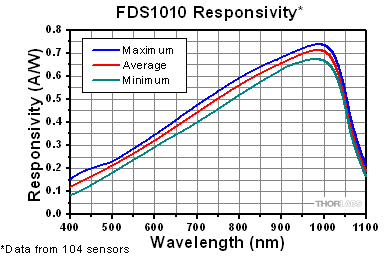
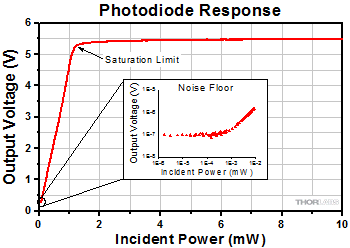

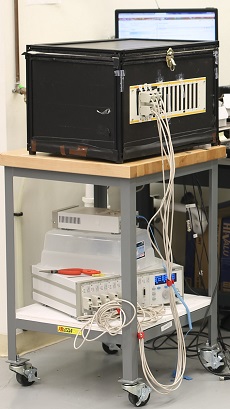
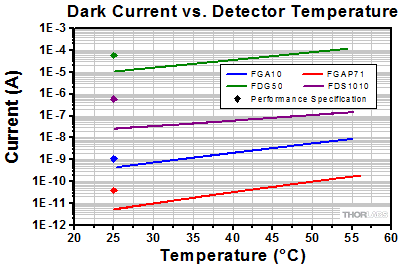
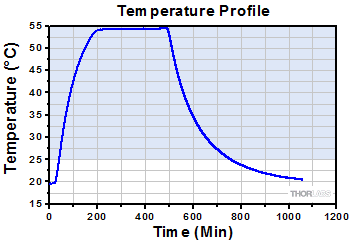
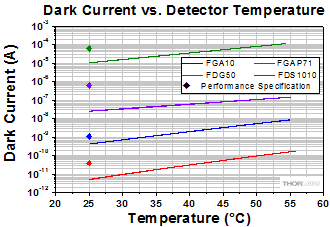
_Power_Plot_G1-300.gif)
_Power_Plot_G1-300.gif)
_Power_Plot_G1-300.gif)


 ズーム
ズーム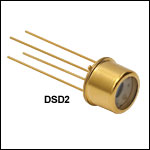
 マウント無しフォトダイオード
マウント無しフォトダイオード